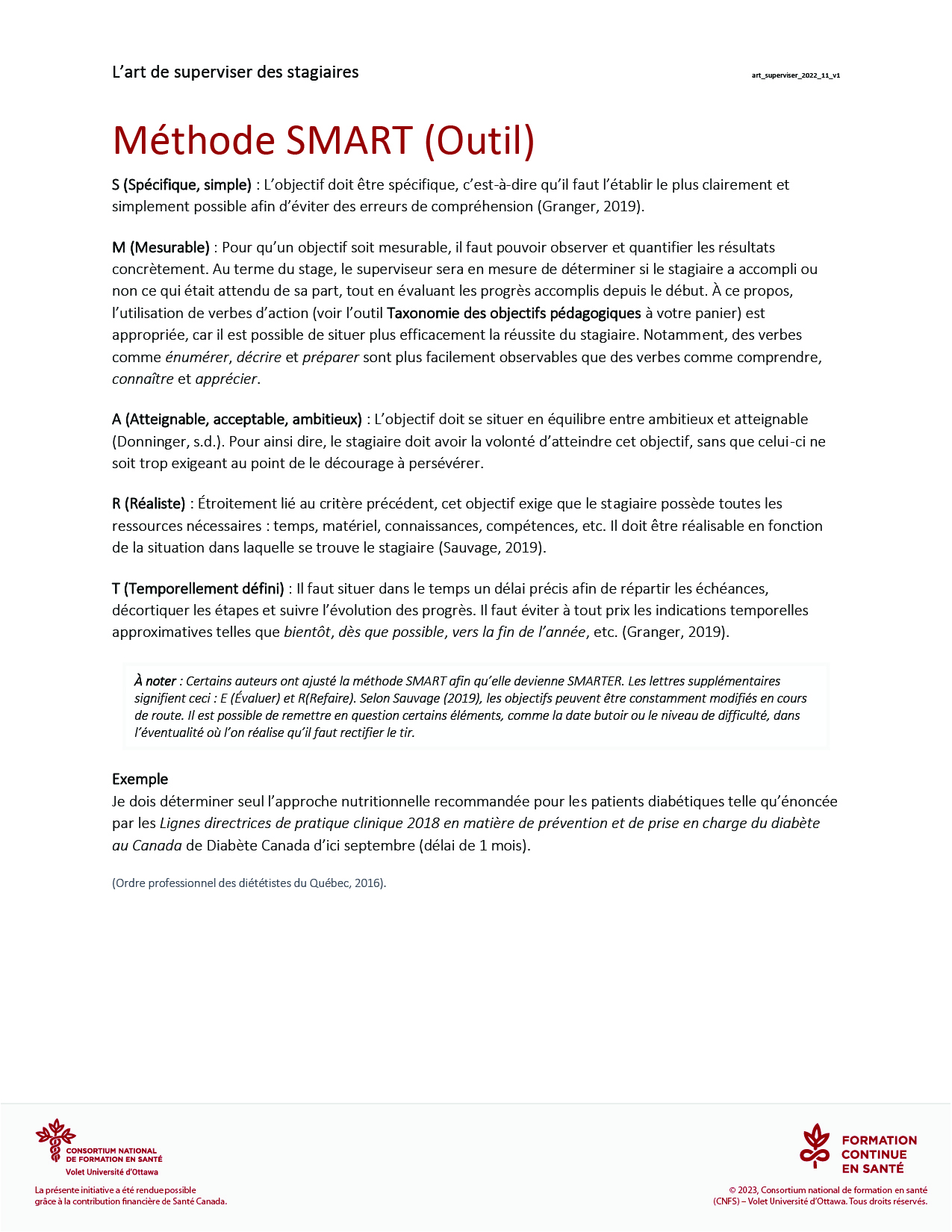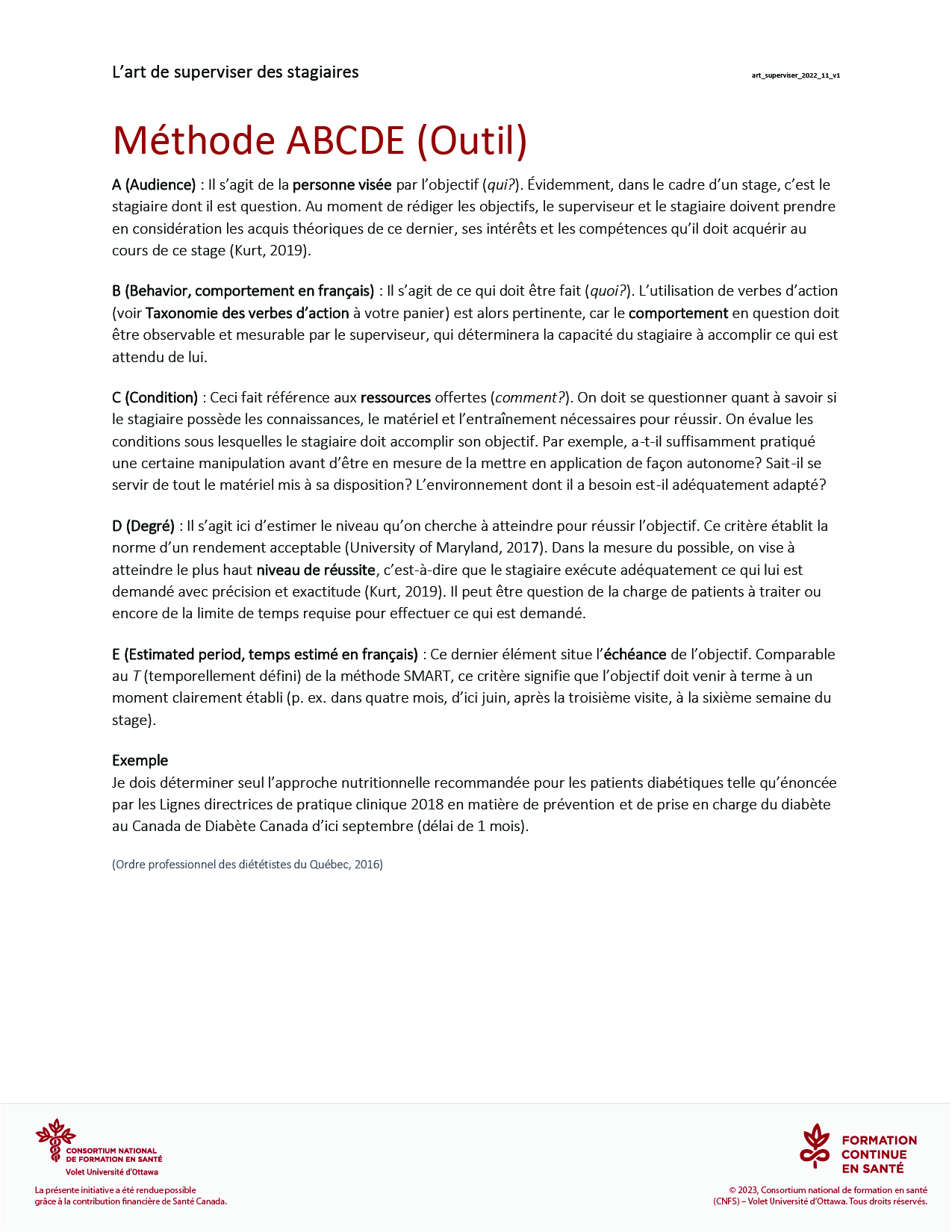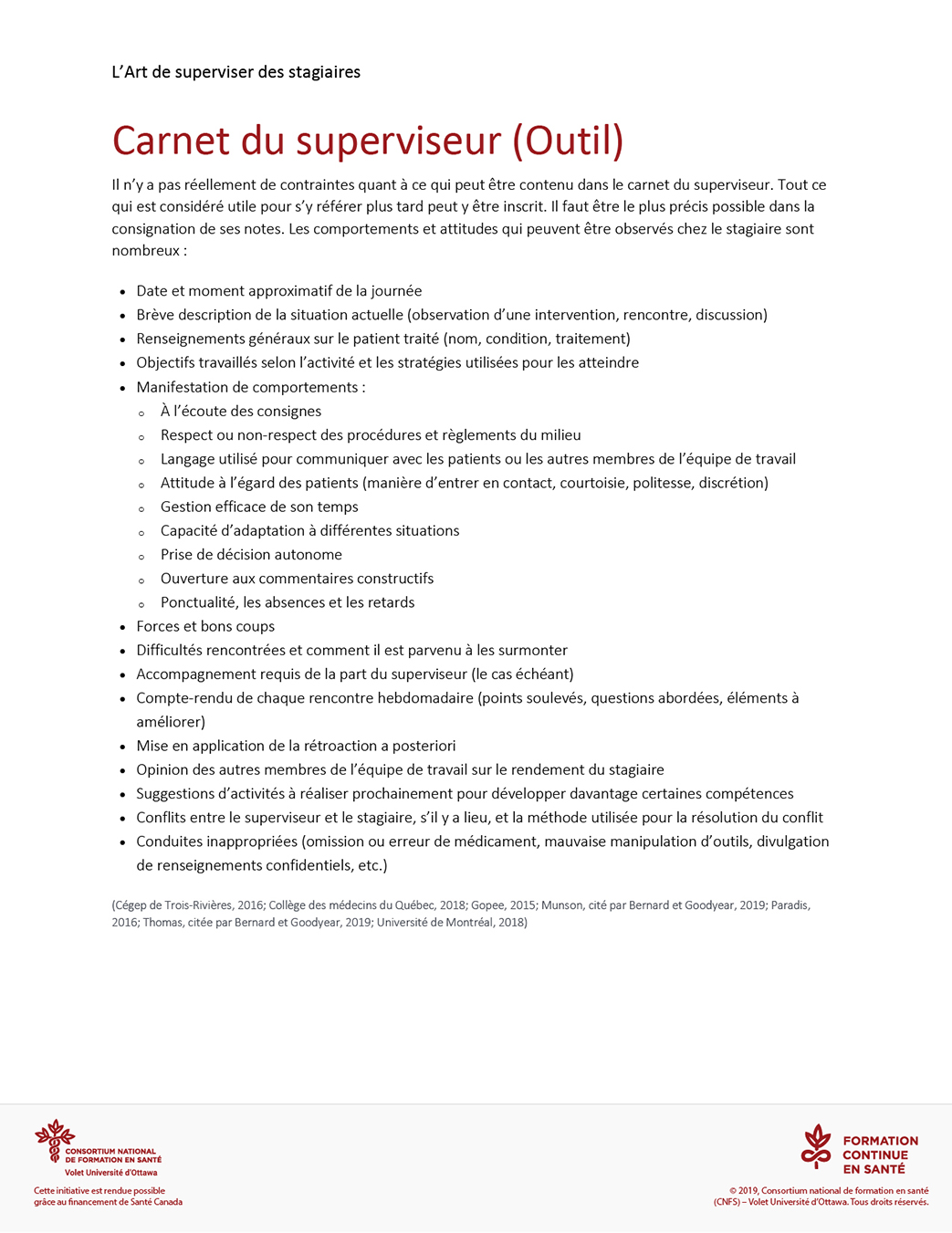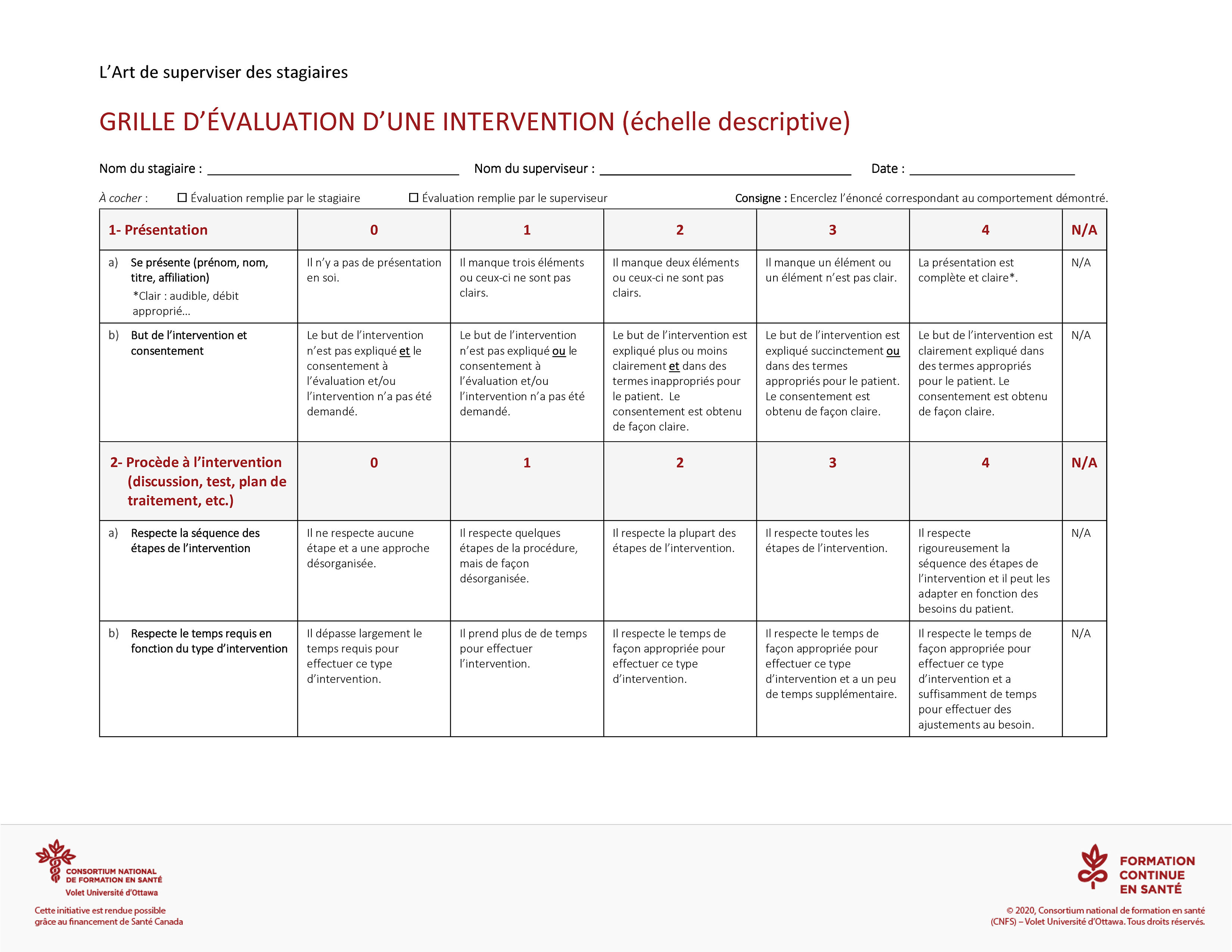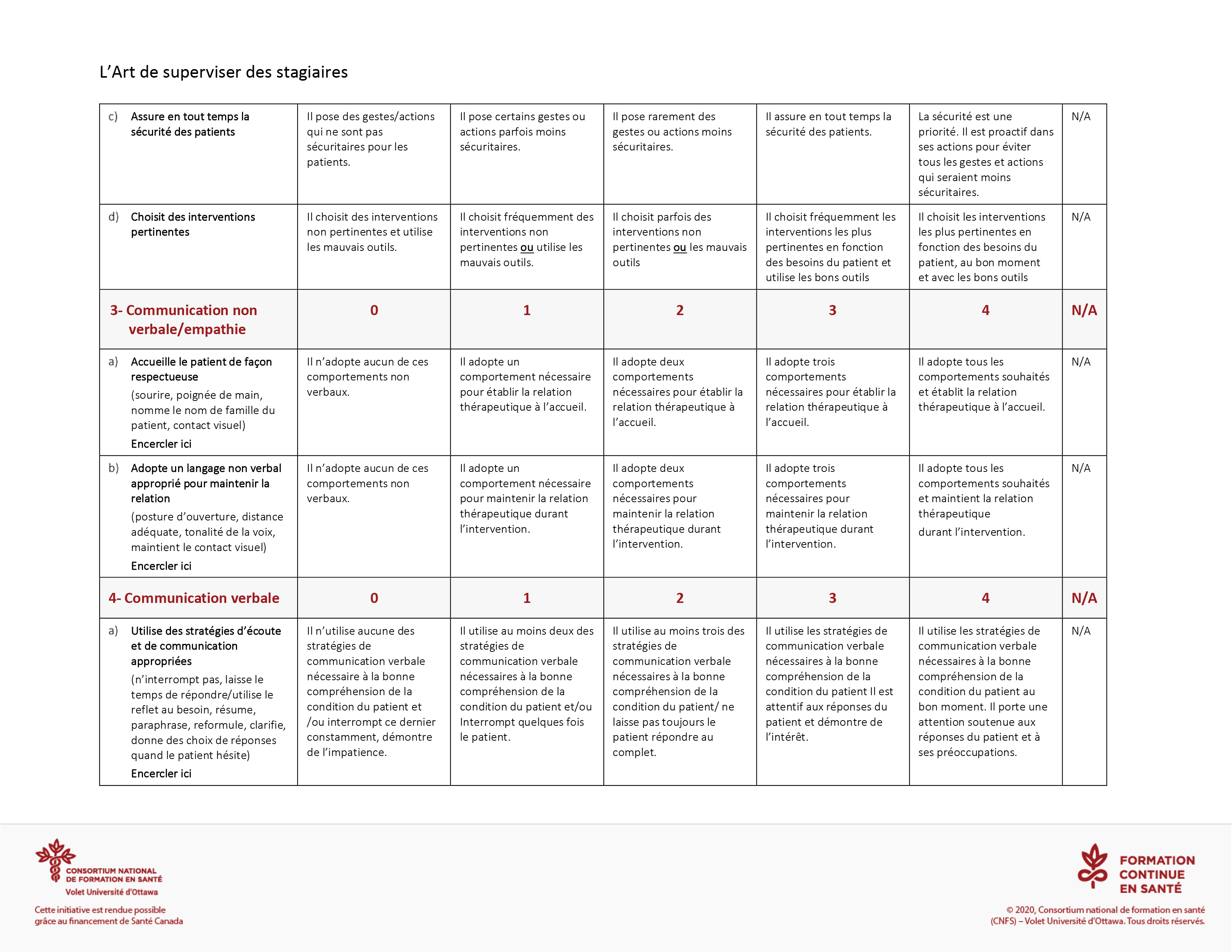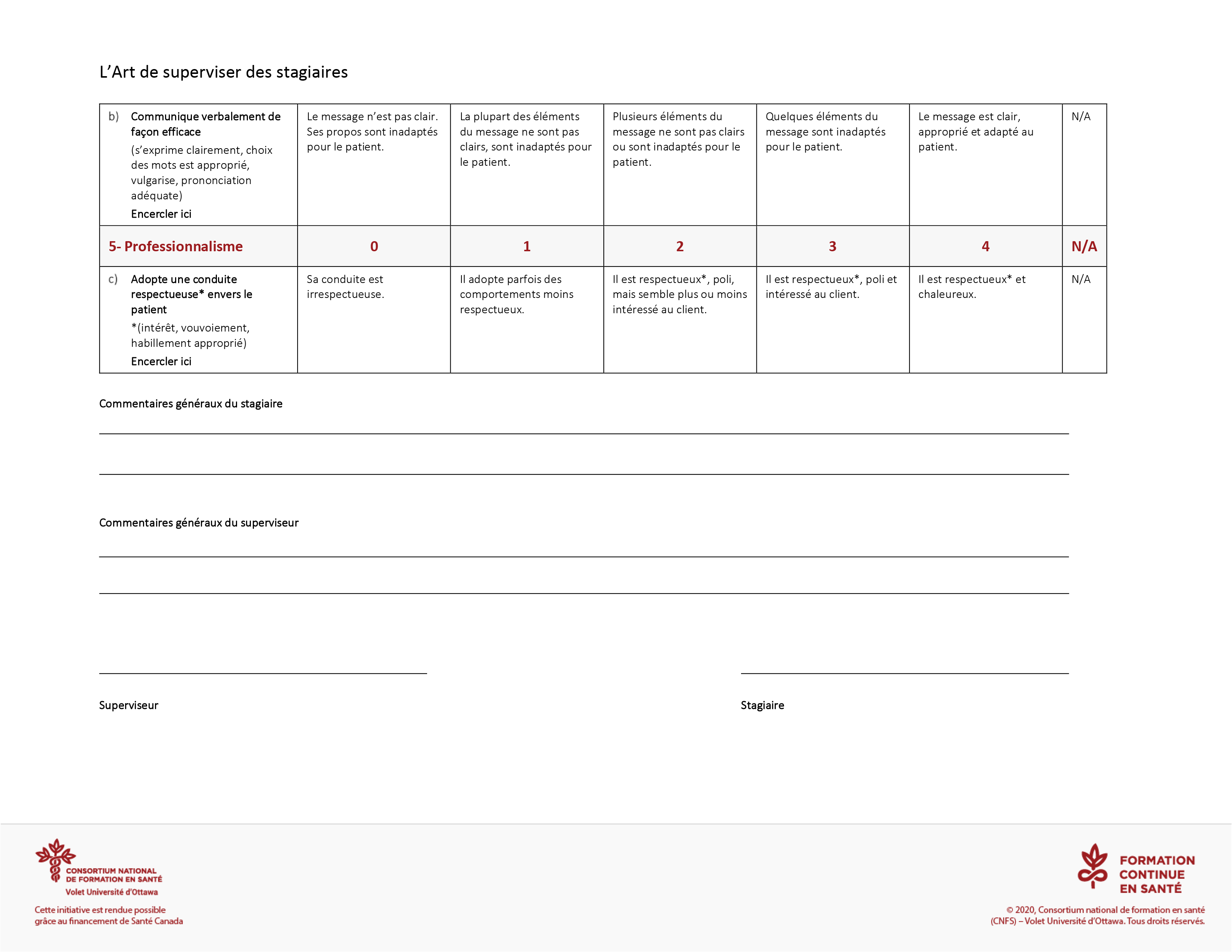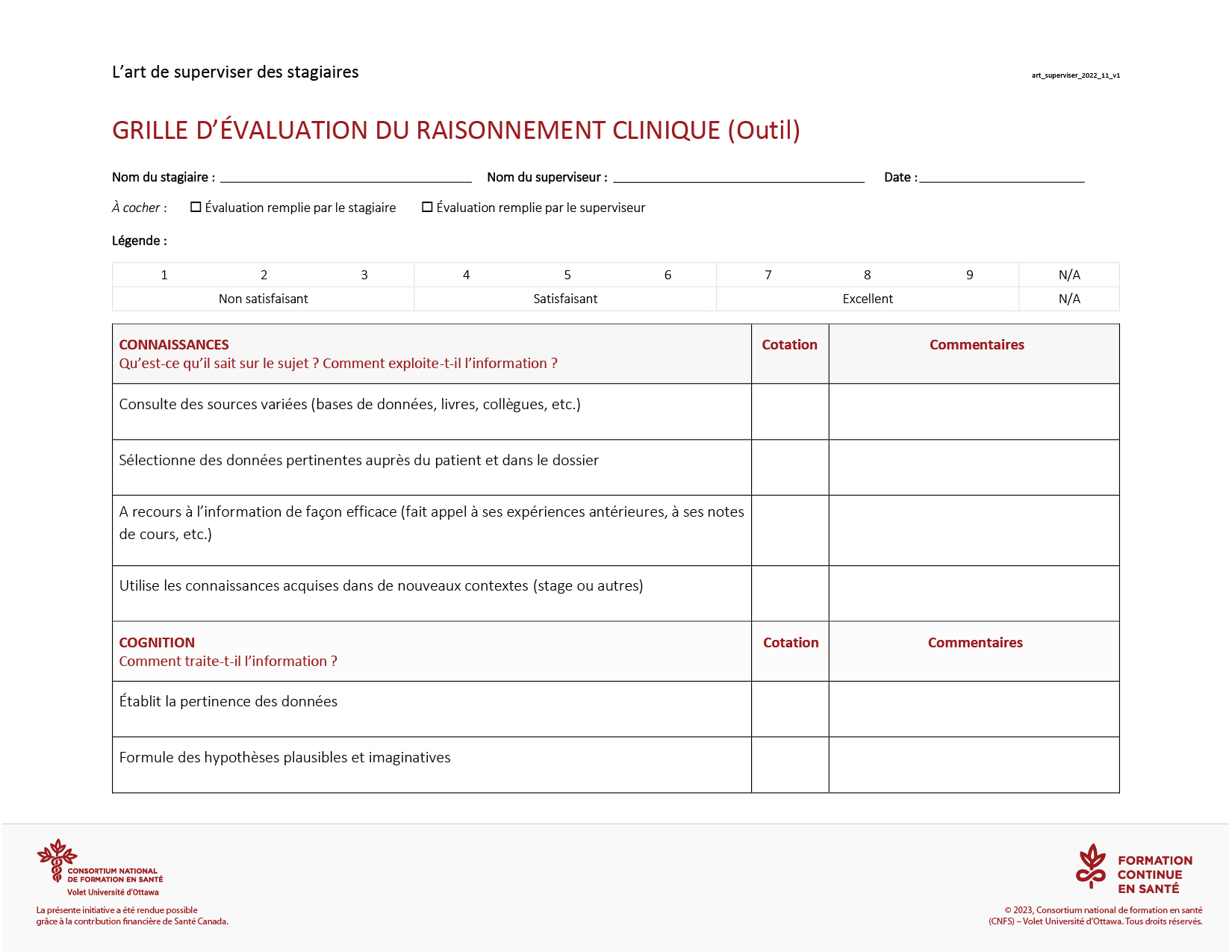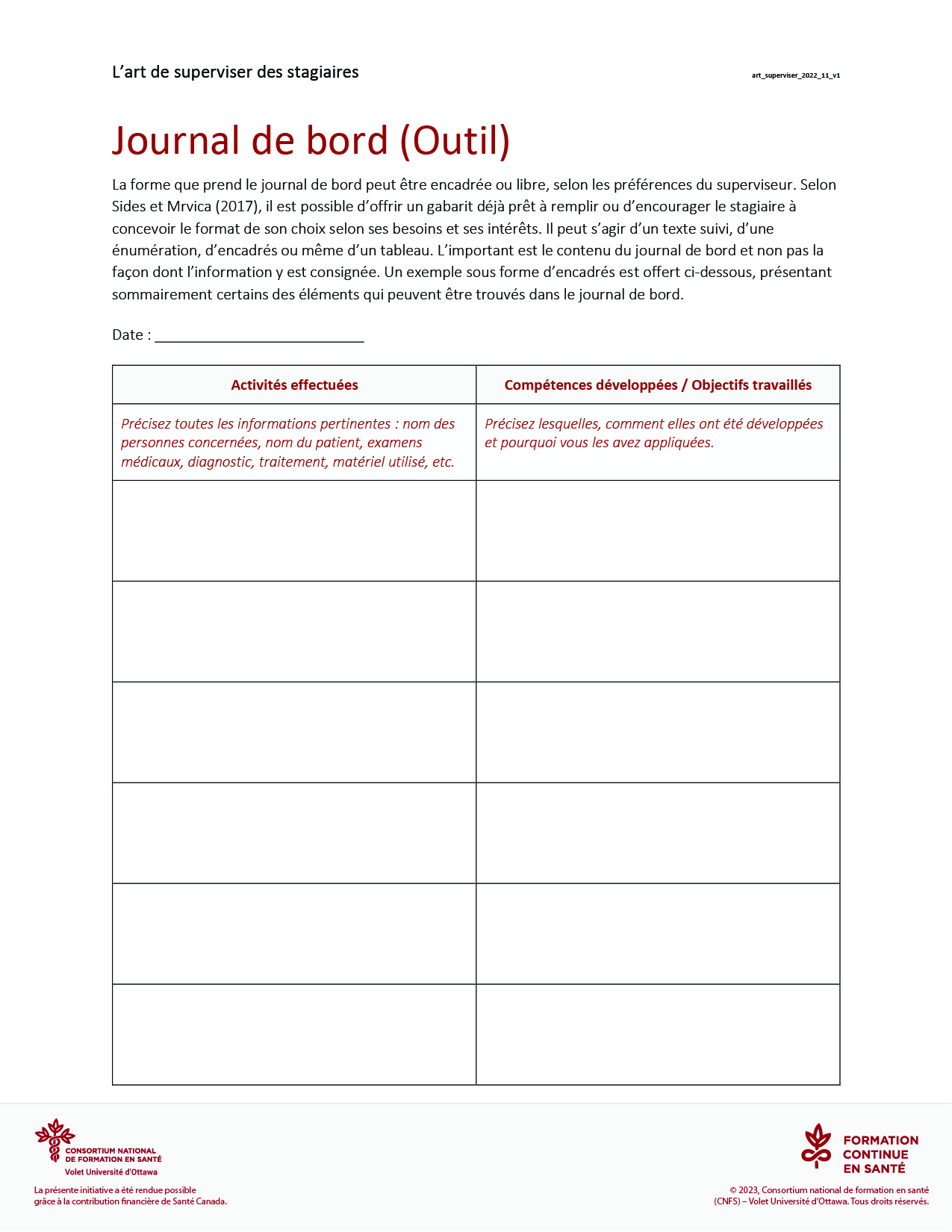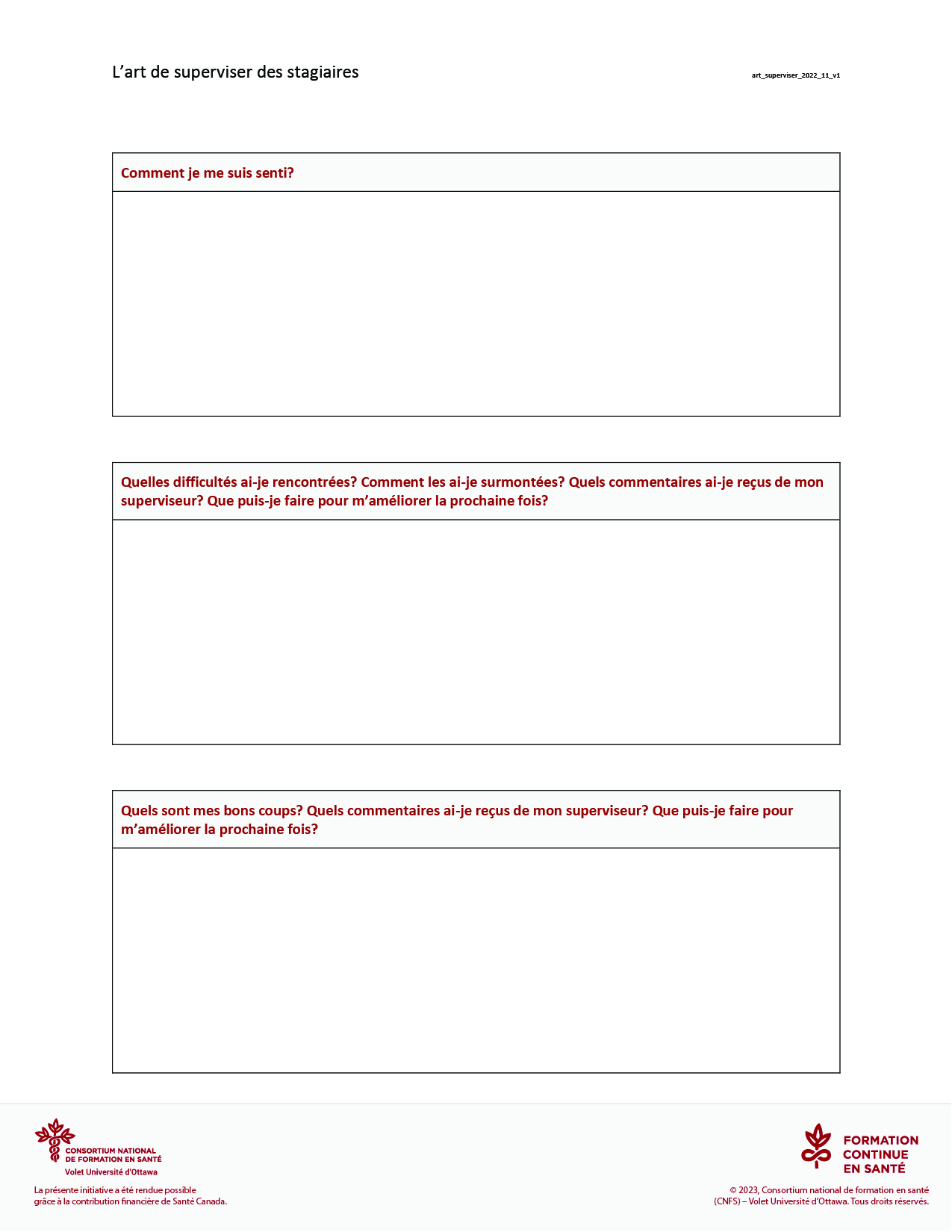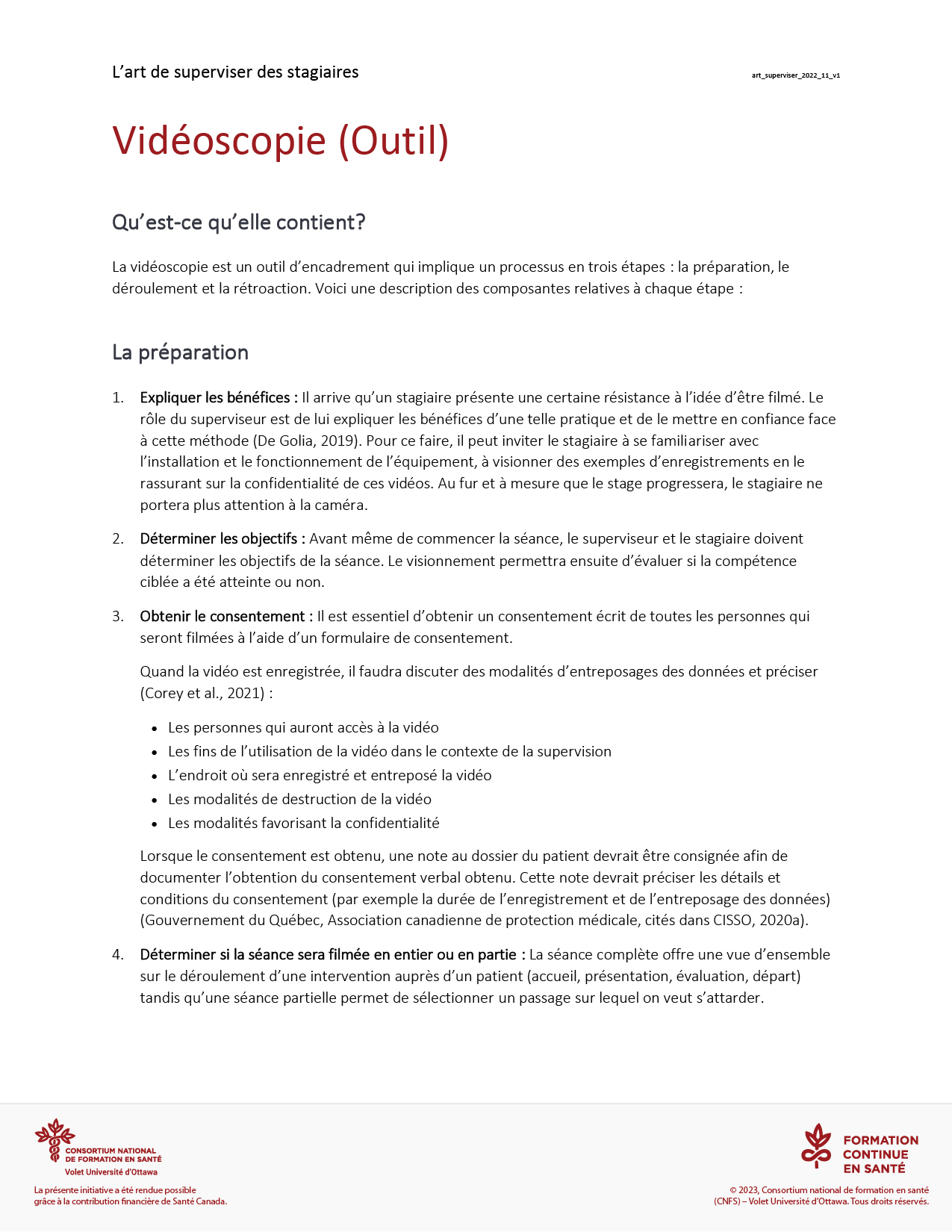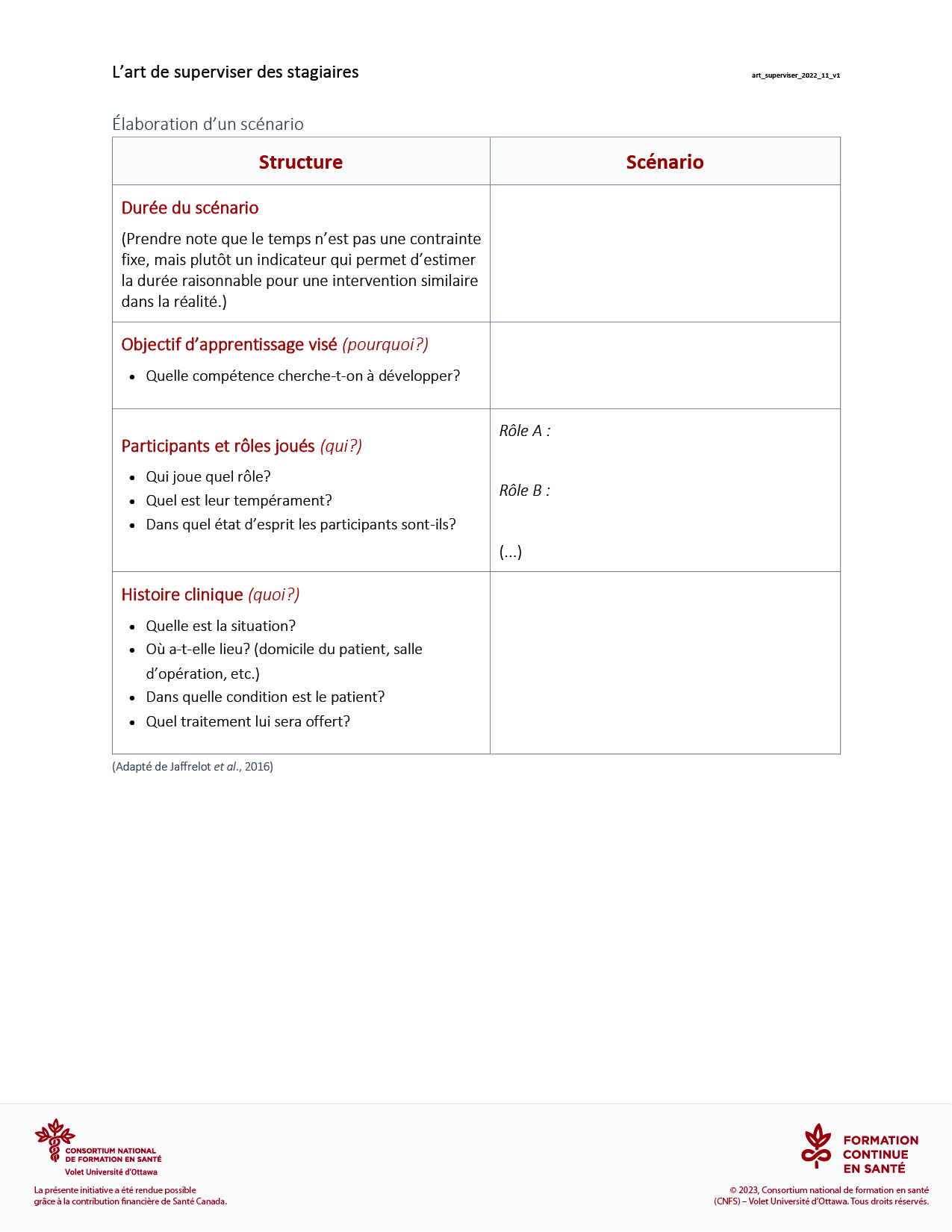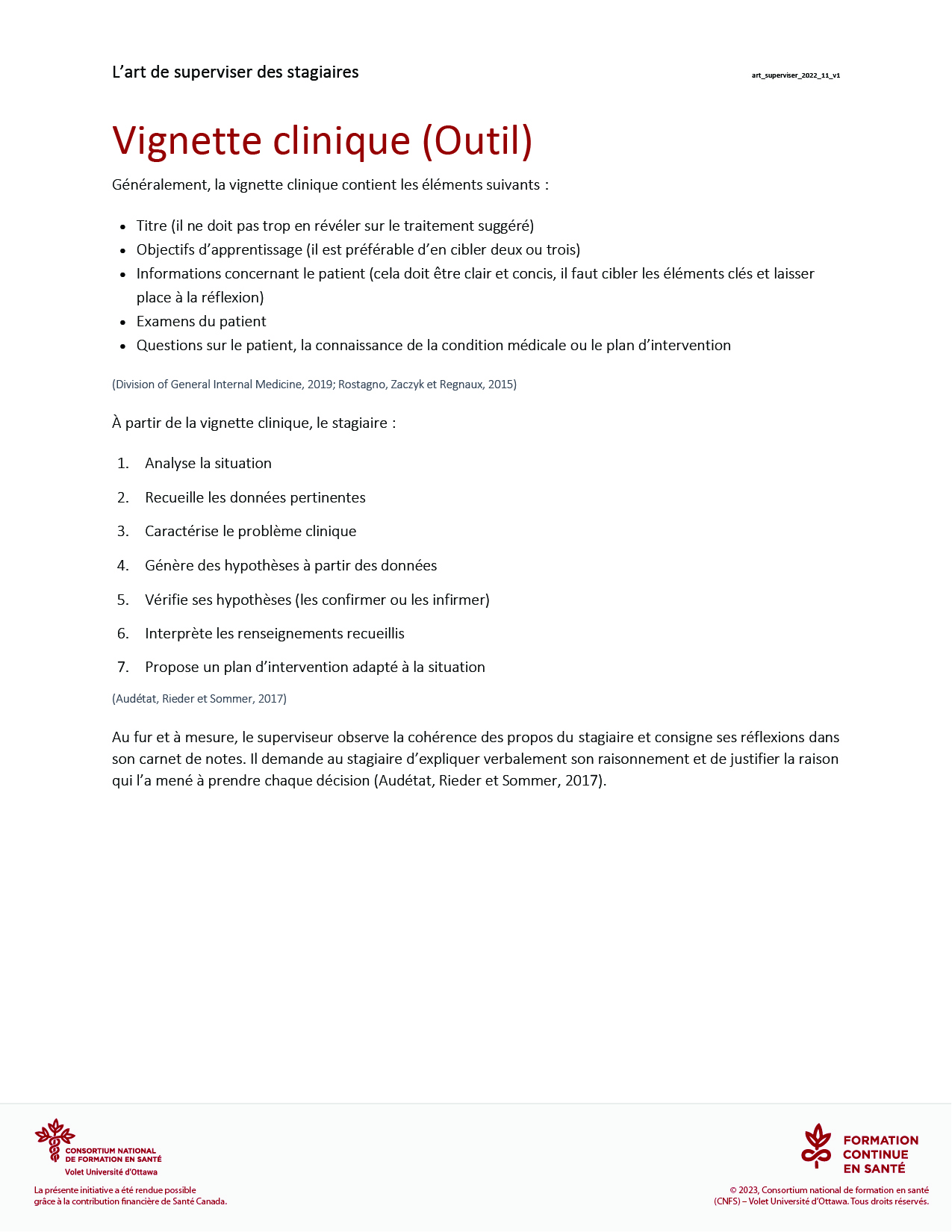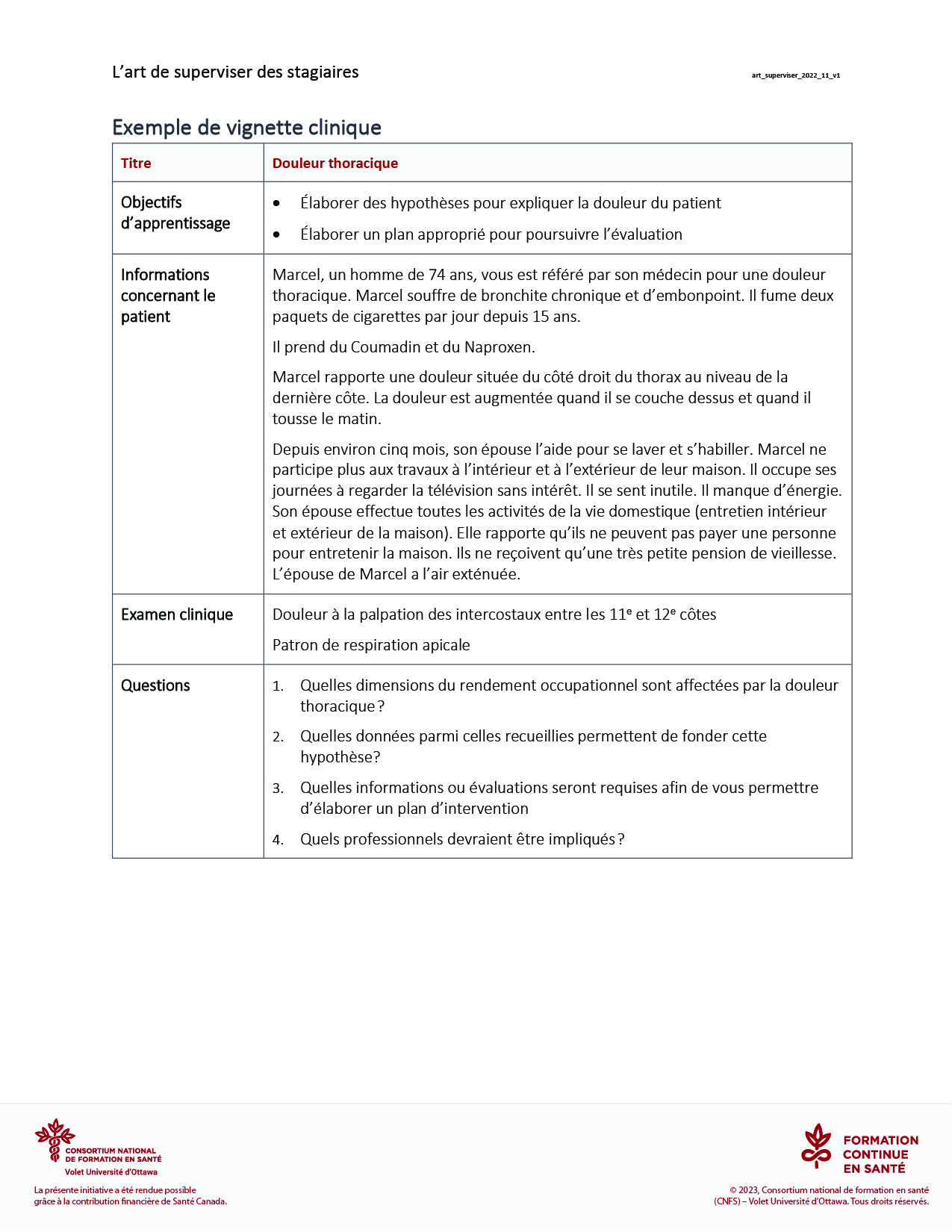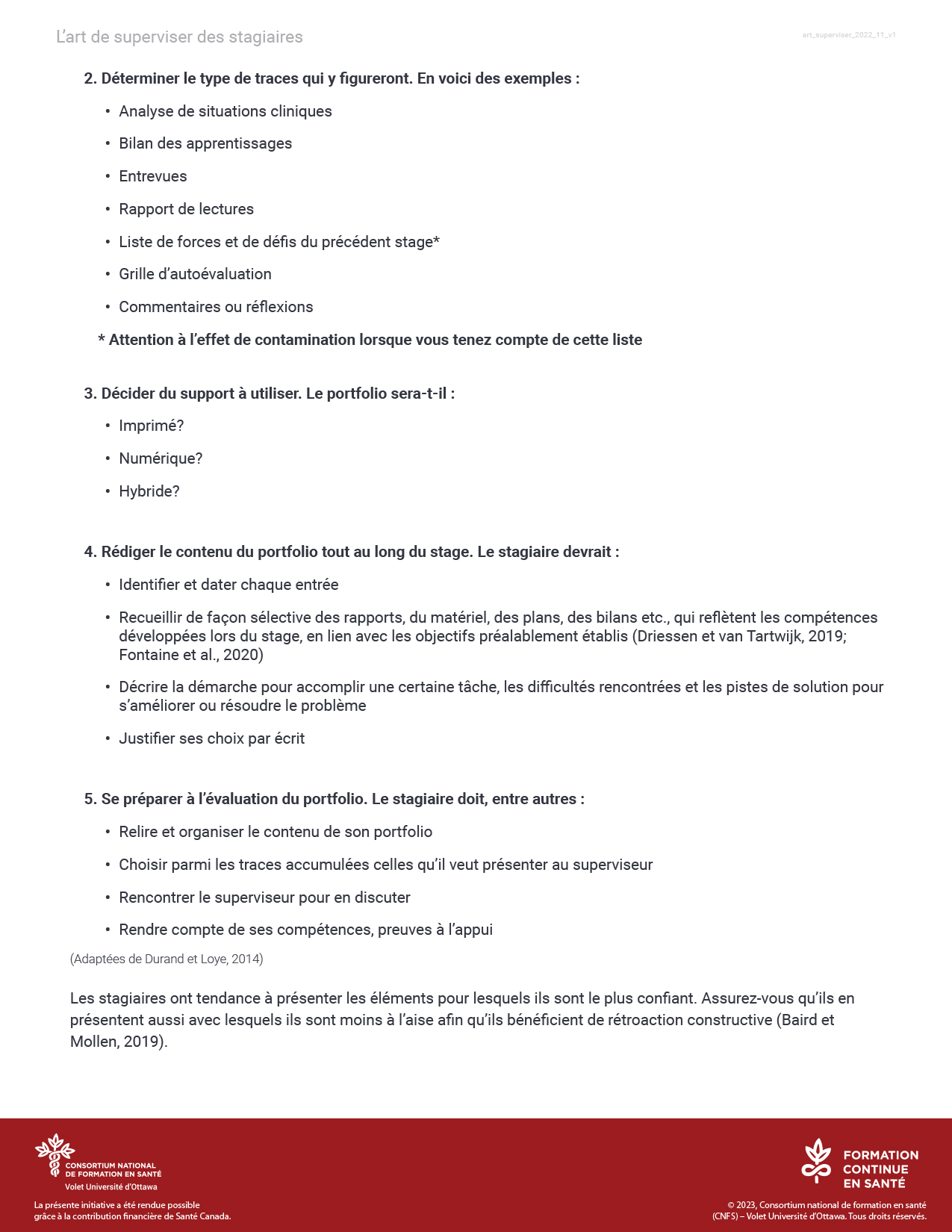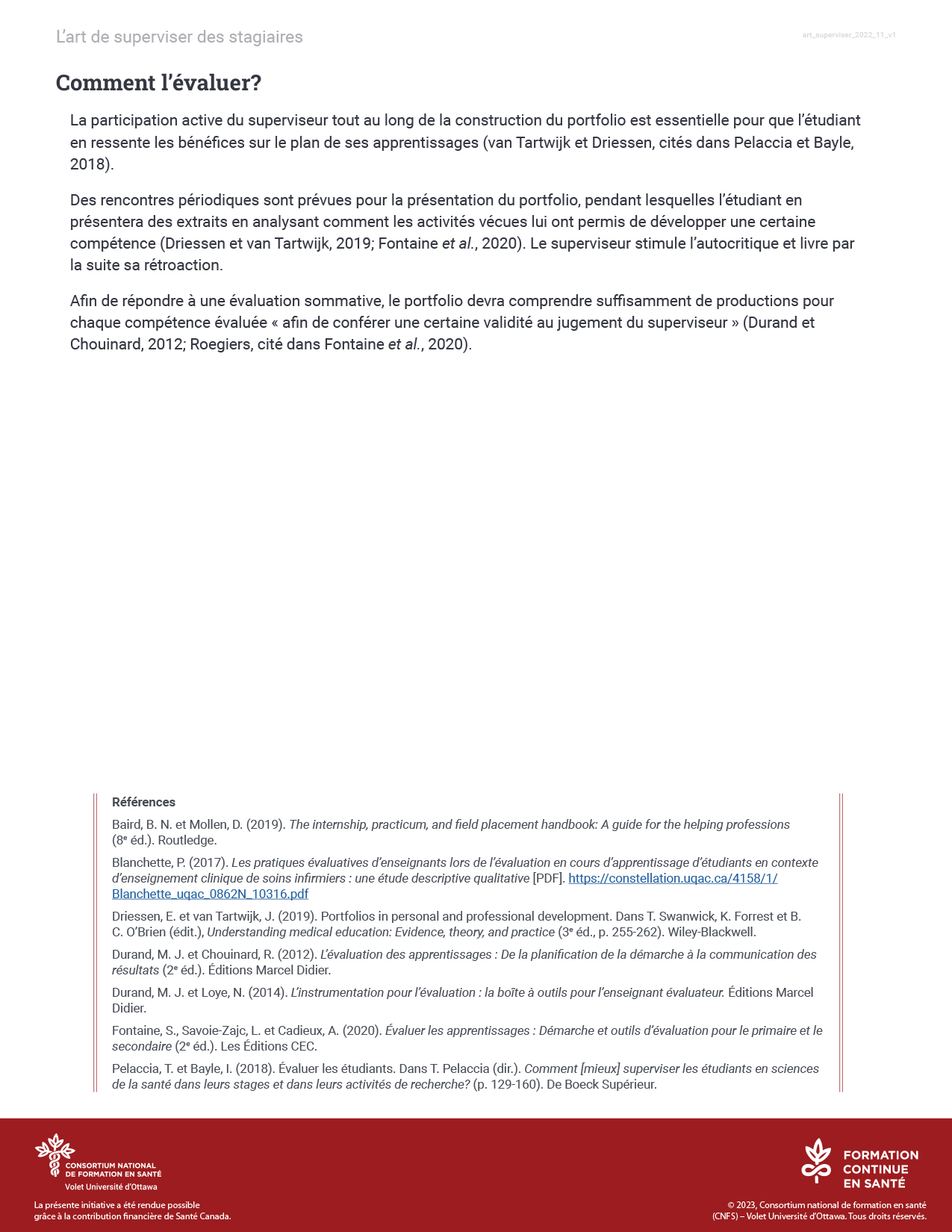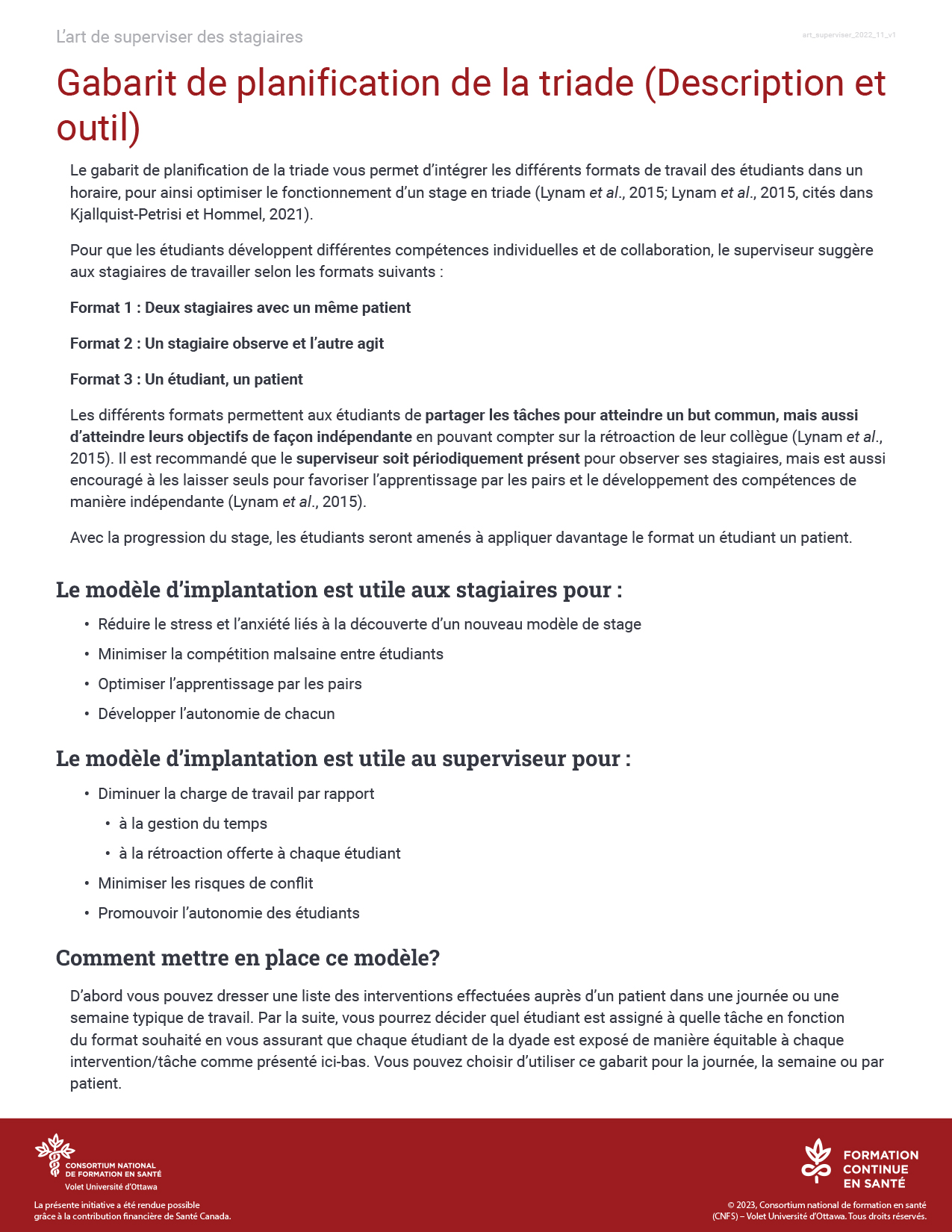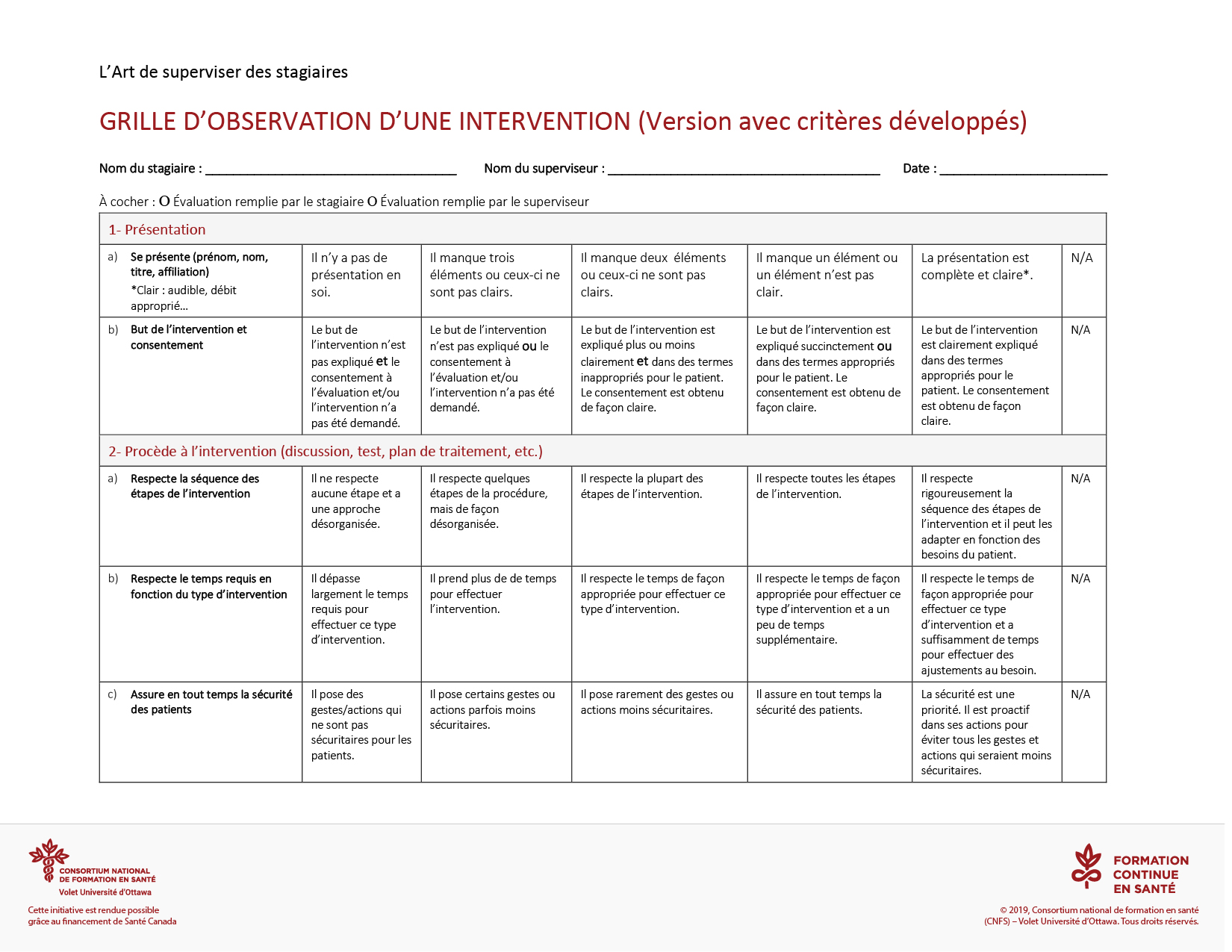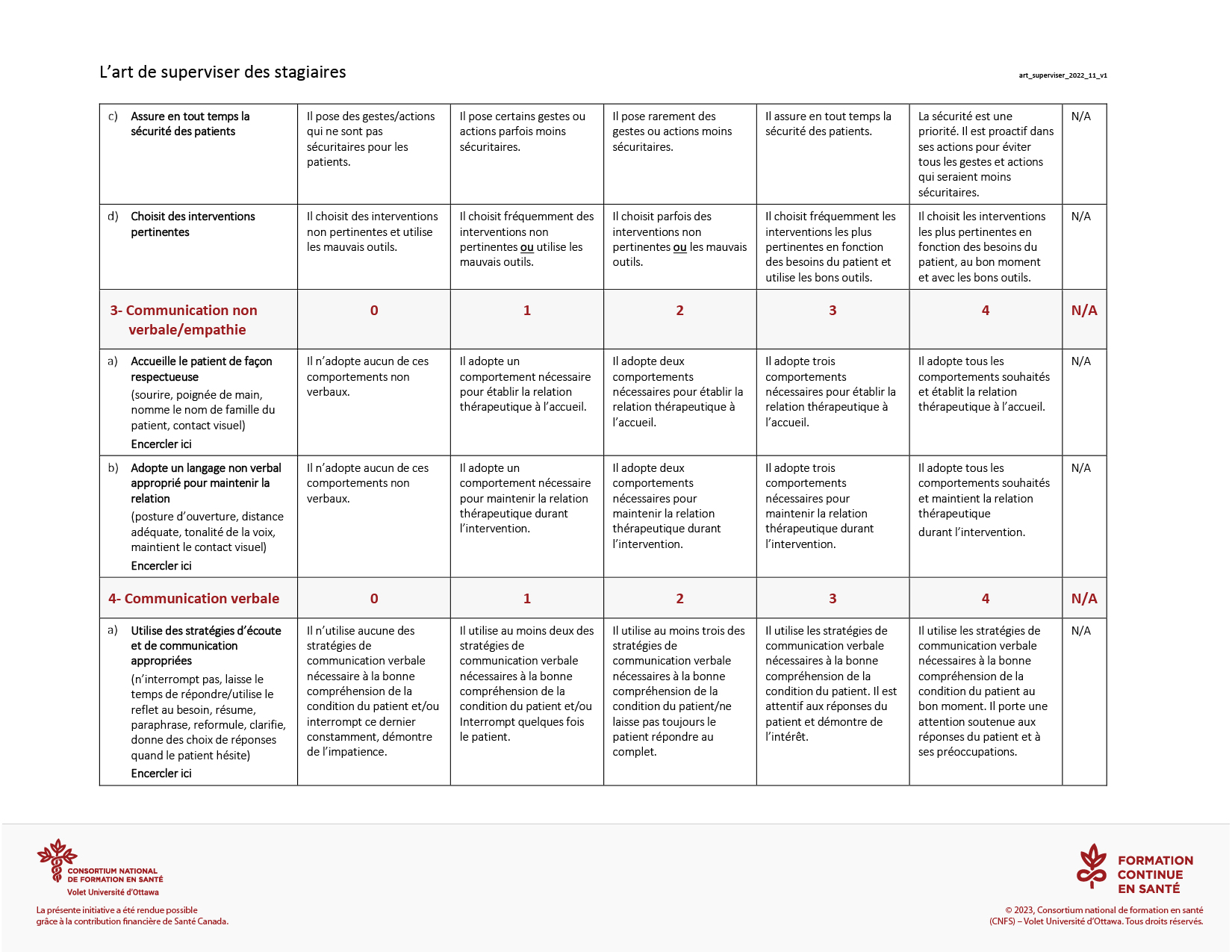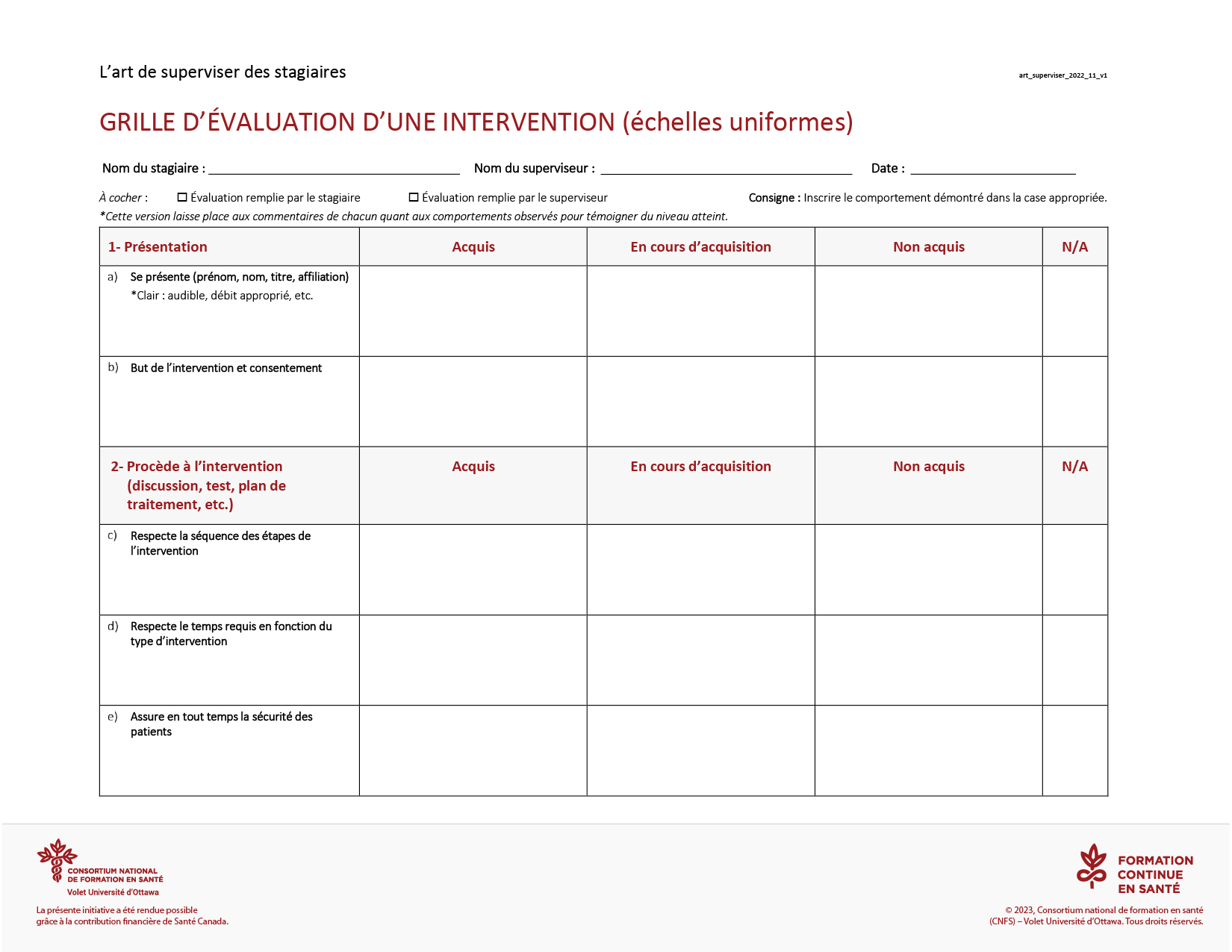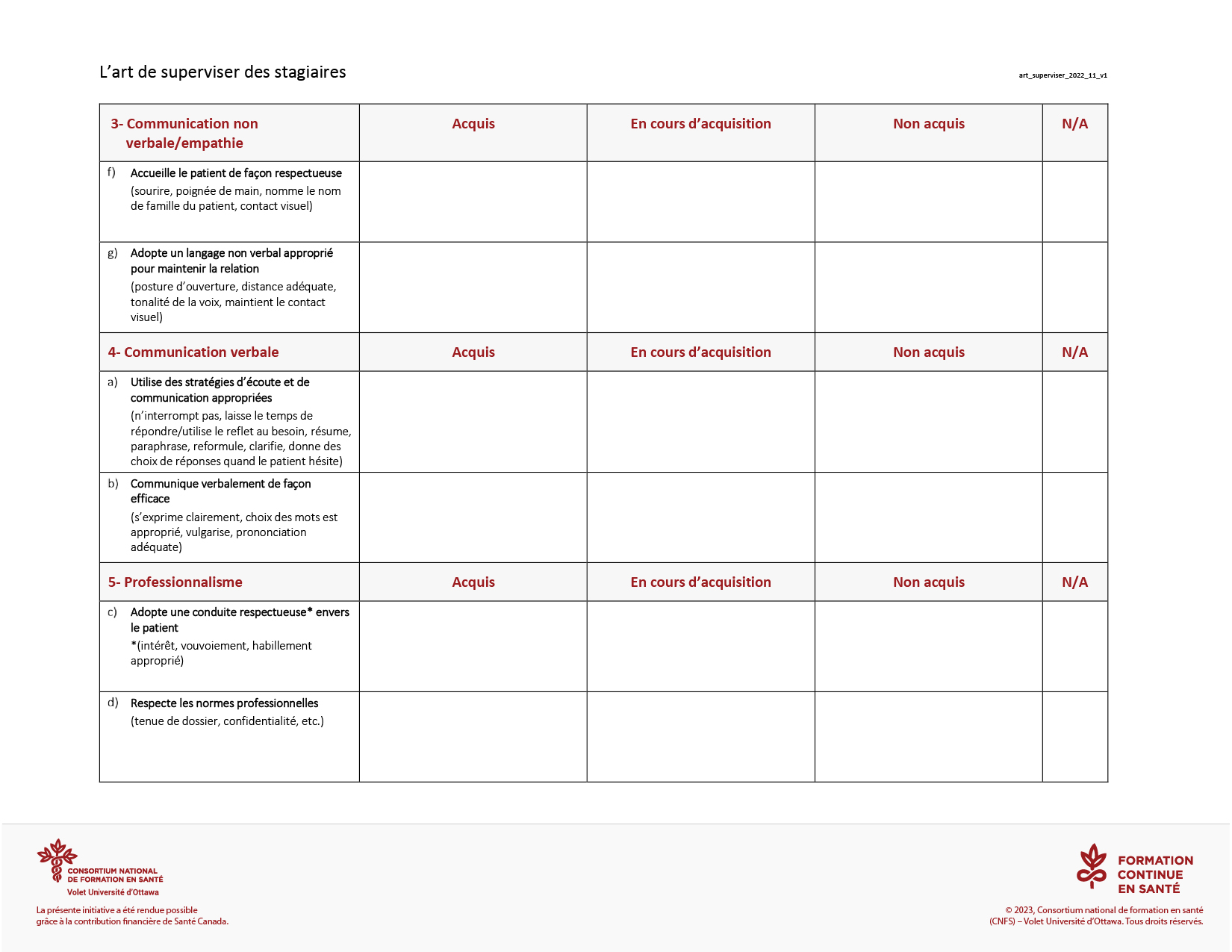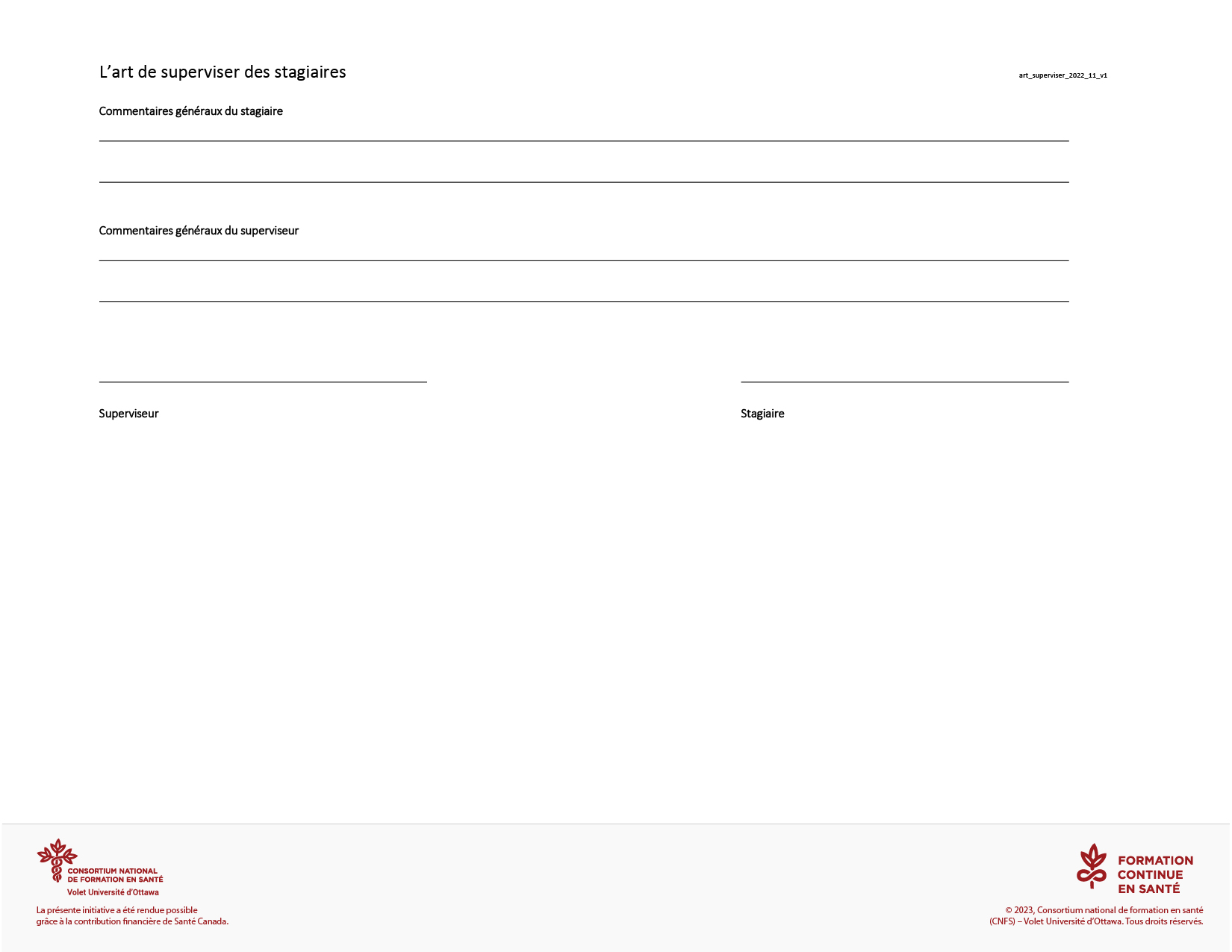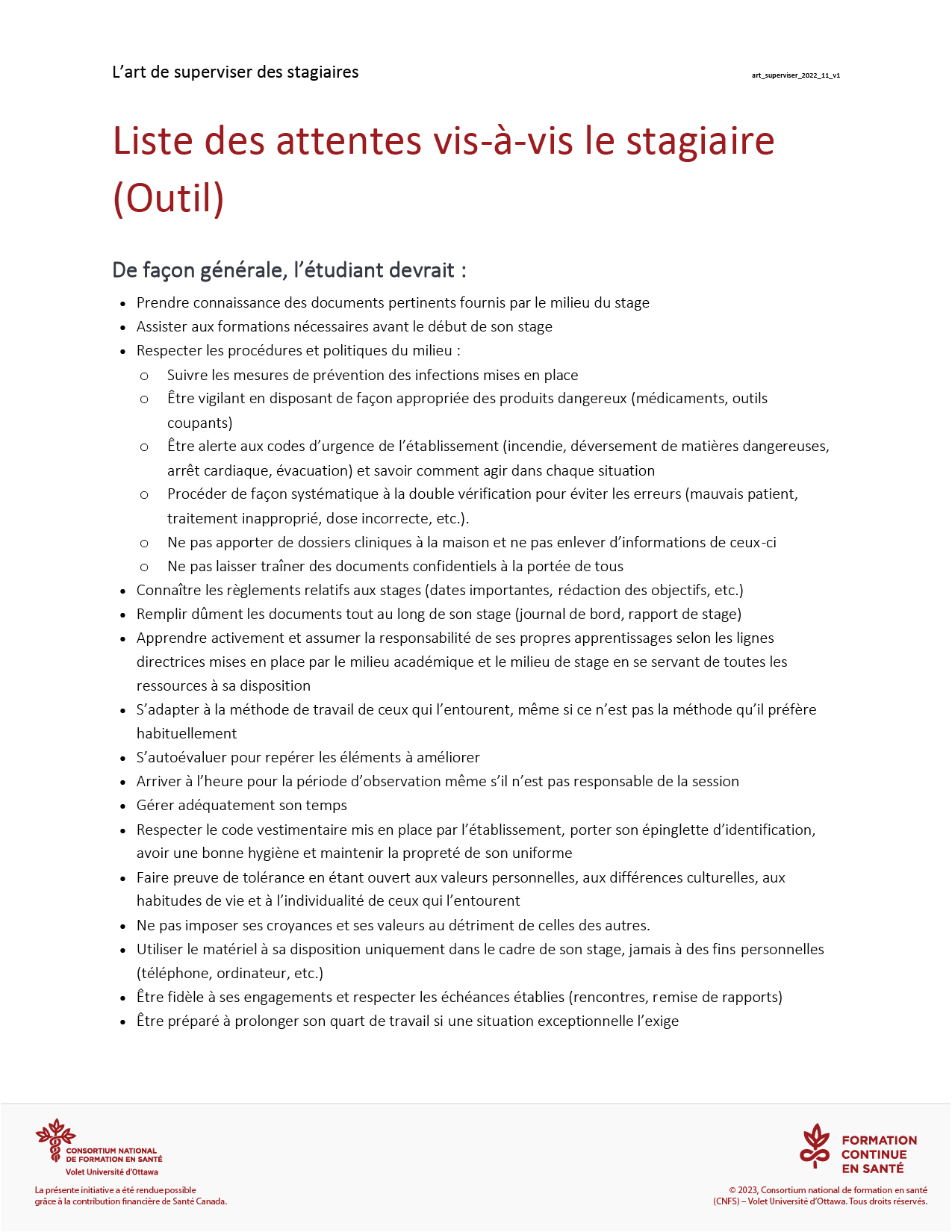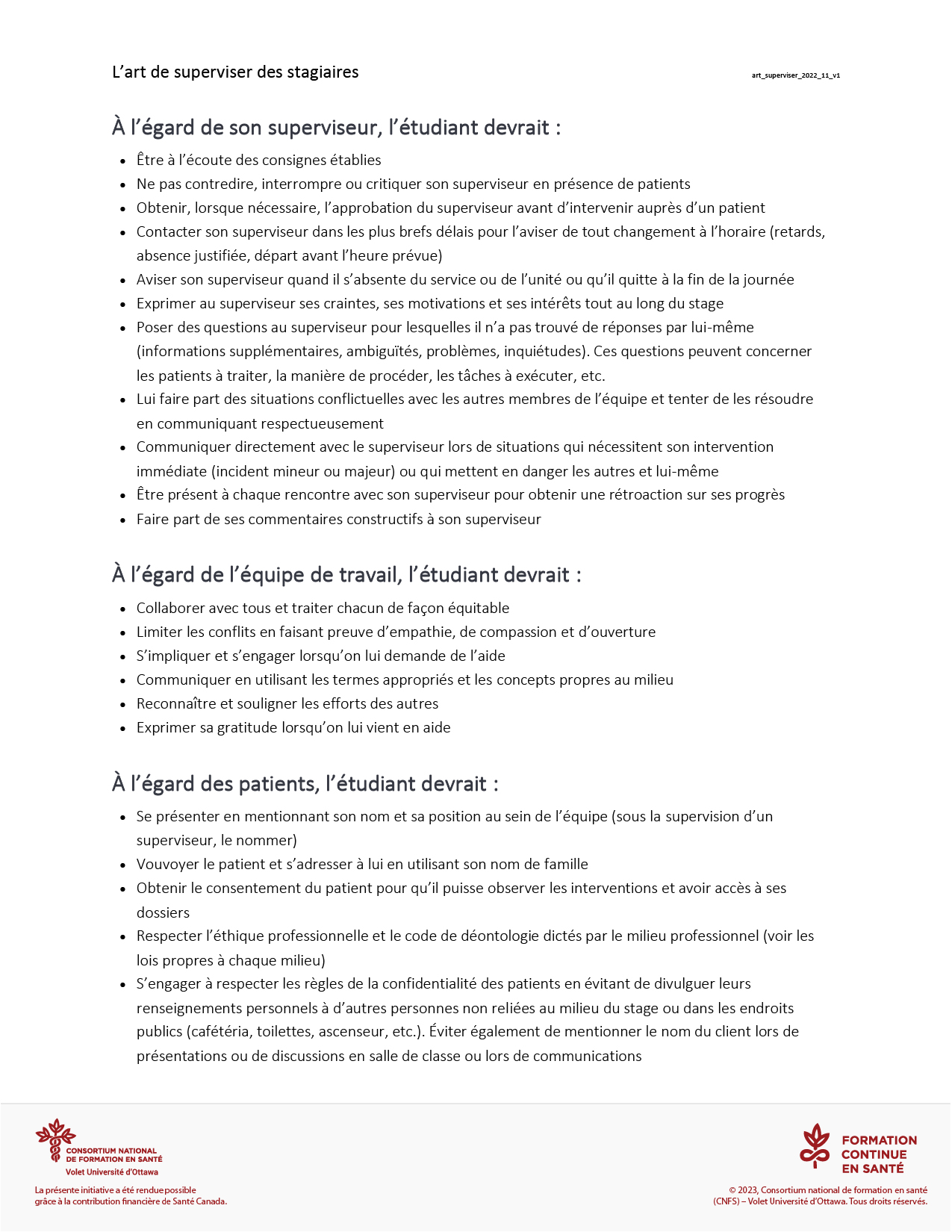BIBLIOGRAPHIE
Besoin d’une copie pour vos dossiers? Téléchargez la version imprimable de cette bibliographie (.pdf, 309 Ko).
A
- Aasheim, L. (2012). Practical clinical supervision for counselors. An experiential guide. New York, N.Y. : Springer Publishing Company.
- Alliance canadienne des organismes de réglementation de la physiothérapie (ACORP). (2017). Réadaptation à distance en physiothérapie – Lignes directrices pour les physiothérapeutes. https://www.alliancept.org/fr/publications/
- Alpine, F. T. C. et Barrett, E. M. (2019). Evaluation of a 2 to 1 peer placement supervision model by physiotherapy students and their educators. Physiotherapy Theory and Practice, 35(8), 748-755.
DOI: 10.1080/09593985.2018.1458168 - Alschuler, M. (2021). Social work group supervision. Dans O’Donoghue, K. et Engelbrecht, L. (dir.), The Routledge International Handbook of Social Work Supervision (1re éd., 702). Routledge.
- Alt, D. et Raichel, N. (2020). Higher Education Students’ Perceptions of and Attitudes Towards Peer Assessment in Multicultural Classrooms. Asia-Pacific Edu Res, 29(6), 567-580.
- Anderson, M. (2018). DESC: Your script for becoming more assertive. Become a CPA Blog. https://www.wscpa.org/community/future-cpas/become-a-cpa-blog/wscpa-blog/2018/01/23/desc-your-script-for-becoming-more-assertive#.Y-zsXK3MKM9
- Association canadienne de la formation en travail social (ACFTS). (2020). Module-Supervision de stage à distance [PDF]. Module-supervision-de-stage-à-distance.Final_.pdf (caswe-acfts.ca)
- Aufegger, L., Soane, E., Darzi, A. et Bicknell, C. (2020). Shared leadership in tertiary care: Design of a simulation for patient safety decision-making in healthcare management teams. BMJ Simulation & Technology Enhanced Learning, 0, 1-7.
B
- Bachkirova, T., Jackson, P. et Clutterbuck, D. (2021). Coaching and Mentoring Supervision: Theory and Practice (2e éd.). McGraw-Hill Education.
- Baird, B. N. (2008). The internship practicum and field placement handbook. A Guide for the helping profession (5e éd.). Upper Saddle River, N.J. : Pearson Prentice Hall.
- Barrett E. M., Belton, A. et Alpine, L. M. (2021). Supervision models in physiotherapy practice education: student and practice educator evaluations. Physiotherapy Theory and Practice, 37(11), 1185-1198.
- Beddoe, L. et Davys, A. (2016). Challenges in Professional Supervision: Current Themes and Models for Practice. Londres, Royaume-Uni : Jessica Kingsley Publishers.
- Berney, A. et Dorogi, Y. (2019). Supervision des équipes de soins en psychiatrie de liaison : quelques points de repère. Rev Med Suisse, 15, 344-346.
- Bhagwat, M., Hewetson, R., Jones, L., Hill, A., Nunn, J., Tosh, R. et Cahill, L. (2018). Comparison of paired and single clinical placement models: a time-use analysis. Int J Lang Commun Disord, 53(3), 468-479.
- Bolduc, A., Paquette, J. et Leclerc, B.-S. (2021). Fiche pratique sur les modes de supervision de stage [PDF]. https://ruisss.umontreal.ca/wp-content/uploads/2021/04/RUISSS-fiche_comite_enseignement_modes_supervision_stage_avril2021.pdf
- Bostock, L., Patrizo, L., Godfrey, T., Munro, E. et Forrester, D. (2019). How do we assess the quality of group supervision? Developing a coding framework. Children and Youth Services Review. 100, 515-524.
- Brewer, M., Duncanson, K., Sanderson, B., Colliver, J., Gribble, N. et Reubenson, A. (2019). Strategies for fieldwork supervisors [PDF]. https://www.curtin.edu.au/file/pdf/strategies-for-fieldwork-supervisors.pdf
- Brunelle, J., Coulibaly, A., Brunelle, J.-P., Martel, D. et Spallanzani, C. (1990). La supervision pédagogique, Université Laval, Québec, Revue EP.S, 1991, p. 58-64.
C
- Caldwell, J. et Dodd, K. (2008). Developing a team mentoring model. Nursing Standard, 23(7), 35-39.
- Carey, M. C., Kent, B. et Latour, J. M. (2018). Experiences of under-graduate nursing students in peer assisted learning in clinical practice. JBI Database of Systematic Reviews and Implementation Reports, 16(5), 1190-1219.
- Carré, C. (2019). Sortir des conflits : comprendre, gérer et transformer les affrontements en épisodes constructifs (3e éd.). Eyrolles.
- Casimiro, L., Grenier, G., Tremblay, M., Desmarais, M. et Beaulieu, D. (2014). Une expérience de stage novatrice en nutrition : facteurs facilitants et défis, La formation pratique : allier milieux de pratique et milieux d’enseignement. Reflets, Revue d’intervention sociale et communautaire, 20(1), 130-140.
- Cavanaugh, K., Logan, J. M., Zajac, S. A. et Holladay, C. L. (2021). Core conditions of team effectiveness: Development of a survey measuring Hackman’s framework. Journal of Interprofessional Care, 35(6), 914-919.
- Centre intégré de santé et de services sociaux de l’Outaouais (CISSO). (2020a). Enregistrement des réunions en mode virtuel : fiche télépratique 1.
- Charron, G. (2021). Les meilleures pratiques d’enseignement durant les stages cliniques : point de vue des ex-étudiantes, des préceptrices et des professeures cliniques en sciences infirmières, Thèse soumise à l’Université d’Ottawa [PDF]. https://ruor.uottawa.ca/bitstream/10393/42370/5/Charron_Gabrielle_2021_these.pdf
- Chipchase, L., Hill, A., Dunwoodie, R., Allen, S., Kane, Y., Piper, K. et Russell, T. (2014). Evaluating telesupervision as a support for clinical learning: an action research project. The Higher Education Academy, 2(2), 40-53.
- Choi, B. C. K. et Pak, A. W. P. (2006). Multidisciplinarity, interdisciplinarity, and transdisciplinarity in health research, services, education and policy: 1. Definitions, objectives, and evidence of effectiveness. Clinical and Investigative Medicine, 29(6), 351-364.
- Choi, S. B., Kim, K. et Kang, S-W. (2017). Effects of transformational and shared leadership styles on employees’ perception of team effectiveness. Social Behavior and Personality: an international journal, 45(3), 377-386.
- Christiansen, A. et Bell, A. (2010). Peer learning partnerships: exploring the experience of pre-registration nursing students. Journal of Clinical Nursing, 19(5-6), 803-810.
- Chugh, R., Macht, S. et Harreveld, B. (2021). Supervisory feedback to postgraduate research students: a literature review. Assessment & Evaluation in Higher Education, 47(5), 683-697.
- Clark, C. M. (2015). Conversations to inspire and promote a more civil workplace: Let’s end the silence that surrounds incivility. American Nurse Today, 10(11), 18-23.
- Clarke, C., Martin, M., de Visser, R. et Sadlo, G. (2015). Sustaining professional identity in practice following role-emerging placements: Opportunities and challenges for occupational therapists. The British Journal of Occupational Therapy, 78(1), 42-50.
- Clarke, C., de Visser, R. et Sadlo, G. (2019). From trepidation to transformation: Strategies used by occupational therapy students on role-emerging placements. International Journal of Practice-based Learning in Health and Social Care, 7(1), 18-31.
- Cleak, H. et Zuchowski, I. (2019). Empirical Support and Considerations for Social Work Supervision of Students in Alternative Placement Models. Clin Soc Work J, 47, 32-42.
- Cleak, H. et Smith, D. (2012). Student satisfaction with models of field placement supervision. Australian Social Work, 65(2), 243-258.
- Clutterbuck, D. et Gannon, J. (2019). The Practitioner’s Handbook of Team Coaching (1re éd.). Routledge.
- Coiley, E. et Henninger, S. (2020). Making the Strange, Familiar: Co-Supervision and Effective Partnership. About Campus, 26(2), 30-34.
- Conn, S. R., Roberts, R. L. et Powell, B. M. (2009). Attitudes and satisfaction with a hybrid model of counseling supervision. Educational Technology and Society, 12(2), 298-306.
- Consortium national de formation en santé – Volet Université de Moncton (CNFS – Volet Université de Moncton). (2012). Programme de perfectionnement professionnel en télésanté. Formation en ligne accessible au http://www.umoncton.ca/telesante/
- Consortium pancanadien pour l’interprofessionnalisme en santé - CPIS. (2010). Référentiel national de compétences en matière d’interprofessionnalisme [PDF]. https://www.rcpi.ulaval.ca/fileadmin/media/Coffre_a_outils/CIHC_IPCompetencies-FrR_Sep710.pdf
- Corey, G., Haynes, R. H., Moulton, P. et Muratori, M. (2021). Clinical supervision in the helping professions: A practical guide (3e éd.). John Wiley & Sons.
- Coulton, P. et Krimmer, L. (2005). Co-supervision of Social Work Students: A Model for Meeting the Future Needs of the Profession. Australian Social Work, 58(2), 154-156.
- Curran, V., Casimiro, L., Banfield, V., Hall, P., Lackie, K., Oadasan, Y., Simmons, B., Tremblay, M. et Wagner, S. (2010). Rubrique d’évaluation de la collaboration interprofessionnelle. Récupéré de https://www.mun.ca/medicine/media/production/medicine/documents/research/cchpe/Rubrique-evaluation.pdf/
D
- Dancza, K., Copley, J., Rodger, S. et Moran, M. (2016). The development of a theory-informed workbook as an additional support for students on role-emerging placements. British Journal of Occupational Therapy, 79(4), 235-243.
- Dionne, L. et Petit, M. (2020). Superviser à distance grâce au numérique : le cas des stages. Le Tableau, 9(1).
- Dorner, S., Fowler, T., Montano, M., Janisse, R., Lowe, M. et Rowland P. (2019). Implementing a peer-learning approach for the clinical education of respiratory therapy students. Can J Respir Ther, 55, 21-27.
- Drew, C. (13 novembre 2021). Peer to Peer Learning – Examples, Benefits & Strategies. https://helpfulprofessor.com/peer-learning/
- Driscoll, J., Stacey, G., Harrison-Dening, K., Boyd, C. et Shaw, T. (2019). Enhancing the quality of clinical supervision in nursing practice. Nursing Standard, 34(5).
- Dudding, C. C. (2012). Focusing in on Tele-supervision. https://academy.pubs.asha.org/2012/12/focusing-in-on-tele-supervision/
- Dungey, G., Neser, H. et Sim, D. (2020). New Zealand radiation therapists’ perceptions of peer group supervision as a tool to reduce burnout symptoms in the clinical setting. Journal of Medical Radiation Sciences, 67(3), 225-232.
- Durand, M. J. et Chouinard, R. (2012). L'évaluation des apprentissages : De la planification de la démarche à la communication des résultats (2e éd.). Éditions Marcel Didier.
- Duval, K., Poulin, P., Barras, D., Laliberté, S., Lechasseur, K. et Gallani, M-C. (2019). Une revue intégrative sur le stage en dyade pour l’amélioration de la formation infirmière de premier cycle au Québec. Revue Francophone Internationale de Recherche Infirmière, 5(1), 21-36.
E
- Eichorn, N., Caplan, J., Levy, M., Zarn, M., Moncrieff, D., Sposto, C. et Hoffman, J. E. (2020). Breaking the ice: use of music improvisation to facilitate interprofessional communication. Journal of Interprofessional Education & Practice, 21, 100379.
- Ekstedt, M., Lindblad, M. et Löfmark, A. (2019). Nursing students’ perception of the clinical learning environment and supervision in relation to two different supervision models – a comparative cross-sectional study. BMC Nurs. 18, 49.
- Eubanks, C.F., Warren, J.T. et Muran, J.C. (2021). Identifying Ruptures and Repairs in Alliance-Focused Training Group Supervision. Int J Group Psychother, 71(2), 275-309.
F
- Fagundes, E. D. T., Ibiapina, C. C., Alvim, C. G., Fernandes, R. A. F., Carvalho-Filho, M. A. et Brand, P. L. (2020). Case presentation methods: a randomized controlled trial of the one-minute preceptor versus SNAPPS in a controlled setting. Perspect Med Educ, 9, 245-250.
- Fondation canadienne de la recherche sur les services de santé (FCRSS). (2006). Synthèse de recherche-Le travail en équipe dans les services de santé!
- Fontaine, S., Savoie-Zajc, L. et Cadieux, A. (2020). Évaluer les apprentissages : Démarche et outils d’évaluation pour le primaire et le secondaire (2e éd.). Les Éditions CEC.
- Ford, K., Courtney-Pratt, H., Marlow, A., Cooper, J., Williams, D. et Mason, R. (2016). Quality clinical placements: The perspectives of undergraduate nursing students and their supervising nurses. Nurse Education Today, 37(1), 97-102.
- Forfa, M., Helfrich, C. et Simon, R. (2022). Perceptions on Non-traditional Models of Fieldwork Supervision. Journal of Occupational Therapy Education, 6(1).
- Fraser, J. (2022). Interdisciplinary success: being an effective and supportive team member. Dans PHYS883 Phototonics Problem solving. Queens University.
G
- Gardner, M., McKinstry, C. et Perrin, B. (2021). Group clinical supervision for allied health professionals. Australian Journal of Rural Health, 29(4), 538-548.
- Grealish, L., Armit, L., Shaw, J., Frommolt, V., Mitchell, C., Mitchell, M., van de Mortel, T. et Billett, S. (2019). Learning through structured peer discussion: An observational study. Nurse Education Today, 82(July), 99-105.
- Grossman, E. et Crowther, N. J. (2015). Co-supervision in postgraduate training: Ensuring the right hand knows what the left hand is doing. South African Journal of Science, 111(11/12), 1-8.
- Grosjean, S., Cherba, M., Nahon-Serfaty, I., Bonneville, L. et Waldolf, R. (2020). Quand la distance reconfigure la pratique clinique. Une analyse multimodale des interactions en télémédecine. Communiquer, Revue de communication sociale et publique, (29).
- Groupe de travail sur les soins virtuels (GTSV). (2020). Soins virtuels : Recommandations pour la création d'un cadre pancanadien [PDF]. https://www.cma.ca/sites/default/files/pdf/virtual-care/RapportduGroupedeTravailsurlesSoinsVirtuels.pdf
H
- Hanson, G. et Robertson, F. (2007). Une expérience d’enseignement de l’anglais dans une FOAD. Dans Manderscheid et Jeunesse (dir.). L’enseignement en ligne. (1re éd.). De Boeck Supérieur.
- Hardavella, G., Aamli-Gaagnat, A., Saad, N., Rousalova, I. et Sreter, K. B. (2017). How to give and receive feedback effectively. Breathe, 13(4), 327-333.
- Himmelfarb Health Sciences Library. (2022). Team Effectiveness: Assessment of Team Performance and Learning. https://guides.himmelfarb.gwu.edu/teameffectiveness/assessment
- Houston, E. (2019). How to successfully Teach Positive Psychology in Groups. https://positivepsychology.com/positive-psychology-groups/
- Hunter, H., et Volkert, A. (2017). Issues and challenges of role-emerging placements. World Federation of Occupational Therapists Bulletin, 73(1), 57-65.
I
J
- Jannas, S. (2019). Comment gérer autrement les conflits au travail? Éditions Yvon Blais.
- Jepson, J., Wells, C. et Biswas, P. (2006). The development of a distance supervision protocol for Allied health profession students on practice placements in non-traditional areas. School of Allied Health Professions, University of East Anglia, Norwich.
- Jones, A. (2019). The Tuckman’s Model implementation, effect, and analysis & the new development of Jones LSI Model on a small group. Journal of Management, 6(4), 23-28.
K
- Kemer, G., Rocha, J., Reiter, A., Dominguez, V. N. et Giresunlu, Y. (2021). Structured Peer Feedback Exchange in Group Supervision of Beginning Supervisors. American Counseling Association, 60, 148-163.
- Kent, F., Glass, S., Courtney, J., Thorpe, J. et Nisbet, G. (2020). Sustainable interprofessional learning on clinical placements: the value of observing others at work. Journal of Interprofessional Care, 34(6), 812-818.
- Kii, W. Y. (2018). Tuckman and Tom Edison Model of Team Developments Applied by Stkip Weetebula Team for Implementation of SPS (Seminar-Practice-School). Journal Edukasi Sumba, 3(1), 38-48.
- King, C., Edlington, T. et Williams, B. (2020). The “Ideal” Clinical Supervision Environment in Nursing and Allied Health. J Multidiscip Healthc, 13, 187-196.
- Kjällquist-Petrisi, A. et Hommel, A. (2021). Preceptors’ experiences of peer learning in an intensive care unit. Nurse Educ Pract, 54:103086.
- Klarowska, B. (2019). Telesupervision: How remote supervision can help. Time2Track. http://blog.time2track.com/supervision-telehealth/
- Koharchik, L. et Redding, S. R. (2016). Strategies for Successful Clinical Teaching – Learning flourishes in a positive environment. American Journal of Nursing, 116(7), 62-65.
L
- Lalwani, J., Jagadeesan, M., Prasanna Karthik, S., Kannan, R. et Damodharan, J. (2021). Effectiveness of Using the SNAPPS Model for Structured Case Presentation in Medicine in Developing Clinical Reasoning [Abstract]. National Conference on Innovations in Health Professions’ Education. Conference Proceedings, p. 57.
- Lamont, S., Brunero, S. et Woods, K. P. (2015). Satisfaction with clinical placement – The perspective of nursing students from multiple universities. Science Direct, 22(1), 125-133.
- Laughran, L. et Sackett, J. (2015). Telesupervision and ASHA's tasks of supervision. Perspectives on Telepractice, 5(1), 4-13.
- Lynam, A.-M., Corish, C. et Connolly, D. (2015). Development of a framework to facilitate a collaborative peer learning 2:1 model of practice placement education. Nutrition & Dietetics, 15(72), 170-175.
M
- Maes, O., Colognesi, S. et Van Nieuwenhoven, C. (2019). Le processus de construction du jugement évaluatif par les superviseurs de stage en enseignement. Mesure et évaluation en éducation, 42(1), 35-62.
- Manges, K., Scott-Cawiezell, J. et Ward, M. (2017). Maximizing team performance: The critical role of the nurse leader. Nursing Forum, 52(1), 21-29.
- Markowski, M., Bower, H., Essex, R. et Yearley,C. (2021). Peer learning and collaborative placement models in health care: a systematic review and qualitative synthesis of the literature. Journal of Clinical Nursing, 30, 1519-1541.
- Martin, P., Kumar, S. et Lizarondo, L. (2017). Effective use of technology in clinical supervision. Internet Interventions, 8, 35-39.
- Martin, P., Lizarondo, L. et Kumar, S. (2018). A systematic review of the factors that influence the quality and effectiveness of telesupervision for health professionals. Journal of Telemedicine and Telecare, 24(4), 271-281.
- Mastoras, S. M. et Andrews, J. J. W. (2011). The supervisee experience of group supervision: Implications for research and practice. Training and Education in Professional Psychology, 5(2), 102-111.
- McKay, M., Davis, M. et Fanning, P. (2018). Messages: the communications skills book. New Harbinger Publications.
- McLaughlin, A., Casey, B. et McMahon, B. (2019). Planning and implementing group supervision: a case study from homeless social care practice. Journal of Social Work Practice, 33(3), 281-295.
- McMaster University. (2011). ECOS-E – Évaluation clinique objective et structurée en équipe McMaster-Ottawa (liste de vérification de l’observateur). Récupéré de http://fhs.mcmaster.ca/tosce/fr/administration_liste.html
- McMaster University. (2020). Emerging Roles: Handbook for Clinical Education [PDF]. https://healthsci.mcmaster.ca/docs/default-source/education/schools/rehab-sciences/physio-role-emerging-handbook-2020-final.pdf?sfvrsn=4f9769b_4
- Miville, A.-M. et Dion-Routhier, J. (2021). L’utilisation de la trace vidéo au cœur du modèle d’accompagnement dans les stages en enseignement primaire. Dans Petit (dir.), Accompagner les stagiaires en enseignement à l’aide du numérique. Éditions JFD.
- Morse, M. D., Raviola, G. et Fricchione, G. (2011). Telesupervision for medical student rotations in global health psychiatry. Academic Psychiatry, 35(6), 415-416.
N
- Nagarajan, S., McAllister, L., McFarlane, L., Hall, M., Schmitz, C., Roots, R., Drynan, D., Avery, L., Murphy, S. et Lam, M. (2015). Australian and Canadian Student and Supervisor Experiences of Telesupervision in Allied Health Clinical Education. International Journal of Practice-based Learning in Health and Social Care, 4(1), 16-27.
- Negaz, M. et Abdennour, I. (2021). La supervision en milieu de pratique : Comment mieux accompagner un stagiaire? Revue Académique des Études Sociales et Humaines, 13(1), 3-16 [PDF]. https://www.asjp.cerist.dz/en/downArticle/552/13/3/144385
- Nordentoft, H. M., Thomsen, R. et Wichmann-Hansen, G. (2012). Collective academic supervision: a model for participation and learning in higher education. Higher Education.
- Nygren, F. et Carlson, E. (2017). Preceptors’ conceptions of a peer learning model: A phenomenographic study. Nurse Education Today, 49, 12-16.
- Nyoni, C. N., Hugo-Van Dyk, L. et Botma, Y. (2021). Clinical placement models for undergraduate health professions students: a scoping review. BMC Med Educ, 21, 598.
O
- Oandasan, I., Robinson, J., Bosco, C., Carol, A., Casimiro, L., Dorschner, D., Gignac, M. L., McBride, J., Nicholson, I., Rukholm, E. et Schwartz, L. (2009). IPC Charter. Charte de la CISS.
- O’Donoghue, K. et Engelbrecht, L. (2021). The Routledge International Handbook of Social Work Supervision. Routledge, 702 p.
- Olmos-Lopez, P. et Sunderland, J. (2017). Doctoral Supervisors and Supervisees’ Responses to Co-supervision. Journal of Further and Higher Education, 41(6), 727-740.
- Ong, Y. H., Hwang Koh, M. Y. et Lim, W. S. (2020). Shared leadership in interprofessional teams: Beyond team characteristics to team conditions. Journal of Interprofessional Care, 34(4), 444-452.
- Ordre des ergothérapeutes de l’Ontario (OEO). (2018). Normes de supervision des étudiants en ergothérapie [PDF]. https://www.coto.org/docs/default-source/default-document-library/normes-de-supervision-des-%C3%A9tudiants-en-ergoth%C3%A9rapie-2018.pdf?sfvrsn=a5a84f8e_0
- Ordre des ergothérapeutes de l’Ontario (OEO). (2021). Services virtuels [PDF]. https://www.coto.org/docs/default-source/default-document-library/services-virtuels.pdf?sfvrsn=7192014e_0
- Ordre des ergothérapeutes du Québec (OEQ). (2014). Stages universitaires supervisés à distance. Considérations liées à la règlementation [PDF]. https://www.oeq.org/DATA/NORME/37~v~stages-supervises-a-distance_guide_doctravail_final_corrige_janvier2014_final.pdf
- Ordre des psychologues du Québec (OPQ). (2019). La supervision Balises de pratiques, réflexions éthiques et encadrement réglementaire [PDF]. https://www.ordrepsy.qc.ca/documents/26707/135241/La+supervision+Balises+de+pratiques%2C+reflexions +ethiques+et+encadrement+reglementaire/04578ade-f5f1-4901-a982-7ab85e12835e
- Ordre professionnel de la physiothérapie du Québec (OPPQ). (2018). Téléréadaptation principes directeurs en physiothérapie [PDF]. https://oppq.qc.ca/wp-content/uploads/OPPQ-telereadaptation_VF_2.pdf
- Overton, A., Clark, M. et Thomas, Y. (2009). A review of non-traditional occupational therapy practice placement education: a focus on role-emerging and project placements. The British Journal of Occupational Therapy, 72(7), 294-301.
P
- Peralta, C. F., Lourenço, P. R., Lopes, P. N., Baptista, C. et Pais, L. (2018). Team development: Definition, measurement and relationships with team effectiveness. Human Performance, 31(2), 97-124.
- Petit, M. (2018). Supervision de stage à distance à l’aide du numérique. Médiations et médiatisations, 1(1), 19-33.
- Petit, M. et Brouillette, L. (2016). Supervision de stage à distance : état des pratiques dans différents domaines de la formation postsecondaire. Communication présentée au Colloque du Réseau d’enseignement francophone à distance du Canada (REFAD), Ottawa.
- Petit, M. et Dionne, L. (2021). Introduction. Dans M. Petit (dir.), Accompagner les stagiaires en enseignement à l’aide du numérique. Éditions JFD.
- Petit, M., Dionne, L. et Brouillette, L. (2019). Supervision de stage à distance : état de la recherche dans différents domaines de formation postsecondaire. Nouveaux cahiers de la recherche en éducation, 21(1), 96-118.
- Pfutzenreuter, T. C., de Lima E. P. et Frega, J. R. (2020). Building high performance teams. EasyChair. https://easychair.org/publications/preprint/Cn86
- Price, D. et Whiteside, M. (2016). Implementing the 2:1 student placement model in occupational therapy: Strategies for practice. Australian Occupational Therapy Journal, 63(2), 123-129.
- Putri, S. T. et Sumartini, S. (2021). Integrating Peer Learning Activities and Problem-Based Learning in Clinical Nursing Education. SAGE Open Nursing, 7, 1-8.
Q
R
- Ravat-Farenc, C. (2019). Conduisez l’entretien de résolution du conflit : le DESC. OpenClassrooms. https://openclassrooms.com/fr/courses/4727076-apprenez-a-gerer-les-conflits/6143381-conduisez-lentretien-de-resolution-du-conflit-le-desc
- Reese, R. J., Aldarondo, F., Anderson, C. R., Lee, S. J., Miller, T. W. et Burton, D. (2009). Telehealth in clinical supervision: A comparison of supervision formats. Journal of Telemedicine and Telecare, 15(7), 356-361.
- Richard., S. (2017). Guide sur la supervision de stage à distance [PDF]. https://www.fadio.net/wp-content/uploads/2018/04/FADIO-Guide-supervision-distance.logo_.pdf
- Roberts, N. J., Brockington, S., Doyle, E., Pearce, L. M., Bowie, A. J., Simmance, N., Evans, S. et Crowe, T. C. (2009). Pilot study of an innovative model for clinical education in dietetics. Nutrition & Dietetics, 66, 39-46.
- Rosenberg, M. B. et Chopra, D. (2015). Nonviolent communication: A language of life: Life-changing tools for healthy relationships. PuddleDancer Press.
S
- Salter, C., Oates, R. K., Swanson, C. et Bourke, L. (2020). Working Remotely: Innovative Allied Health Placements in Response to COVID-19. International Journal of Work-Integrated Learning, 21(5), 587-600.
- Samson, G., Roussel, C., Landry, N. et Lemieux, M.-M. (2017). Les potentialités pédagogiques du manuel numérique : contexte de formation à distance en enseignement supérieur. Dans Lafleur et Samson (dir.), Formation à distance en enseignement supérieur. Presses de l’Université du Québec.
- Sansom, L. et Fraser, J. (2022). Positive psychology in the physics classroom: facilitating high-performance teams. [Discussion]. La société pour l’avancement de la pédagogie dans l’enseignement supérieur (SAPES). Ottawa, Ontario, Canada.
- Scaife, J. (2019). Supervision in Clinical Practice – A Practitioner’s Guide. Routledge.
- Sheppard, F., Stacey, G. et Aubeeluck, A. (2018). The importance, impact and influence of group clinical supervision for graduate entry nursing students. Nurse Education in Practice, 28, 296-301.
- Schmitz, C., Storr, C. et White, C. (2018). How role-emerging placements compare to each other and contribute to occupational therapy practice: A national snapshot. Occupational Therapy Now, 20(1), 14-16.
- Smith, T., Fowler-Davis, S., Nancarrow, S., Ariss, S. M. B. et Enderby, P. (2018). Leadership in interprofessional health and social care teams: A literature review. Leadership in Health Services, 31(4), 452-467.
- Smith, R. D., Riva, M. T. et Erickson Cornish, J. A. (2012). The Ethical practice of group supervision: A National survey. Training and Education in Professional Psychology, 6(4). 238-248.
- Stenberg, M., Bengtsson, M., Mangrio, E. et Carlson, E. (2020). Preceptors' experiences of using structured learning activities as part of the peer learning model: A qualitative study. Nurse Education in Practice, 42, 1-5.
T
- Tessmer, S. S. et Storlie, C. A. (2021). Clinical Supervision of Group Work: A Conceptual Review. Journal of Counselor Practice, 12(1), 48-72.
- Tousignant, K., Vandyk, A., Lalonde, M., Bigras, S., Roggie, S., Weeks, K.-L., Morley, M. et Jacob, J.-D. (2021). Nursing Students in Clinical Placements Learning in Dyads: A Feasibility Study Using a Non-Randomized Pilot Trial. Quality Advancement in Nursing Education - Avancées en formation infirmière, 7(1), Article 3.
- Tucker, R. et Abbasi, N. (2016). Bad attitudes: Why design students dislike teamwork. Journal of Learning Design, 9(1), 1-20.
U
- Ukwoma, S. C. et Ngulube, P. (2020). Supervision Practices in Library and Information Science Postgraduate Research in Nigeria and South Africa. African Journal of Library, Archives and Information Science, 30(2).
- Université du Québec à Chicoutimi. (2006). Guides de stage. Baccalauréat en enseignement de l’éducation physique et à la santé. Université du Québec à Chicoutimi [PDF]. http://www.uqac.ca/gdseps/
- Université du Québec à Montréal (UQAM). (2020). Guide des stages. Programme de baccalauréat, École de travail social. Université du Québec à Montréal, 13 août 2020 [PDF]. https://travailsocial.uqam.ca/wp-content/uploads/sites/57/2020/09/28-08-2020-BAC-Guide-stages-VF-avec-hyperliens.pdf
V
- Vandergoot, S., Sarris, A., Kirby, N. et Ward, H. (2018). Exploring undergraduate students’ attitudes towards interprofessional learning, motivation-to-learn, and perceived impact of learning conflict resolution skills. Journal of Interprofessional Care, 32(2), 211-219.
- Vianin, P. (2019). La supervision pédagogique : L'accompagnement des stagiaires. De Boeck Supérieur.
- Vishakha, J., Siddharth, R. et Jinadani, M. (2019). Effectiveness of SNAPPS for improving clinical reasoning in postgraduates: randomized controlled trial. BMC Medical Education, 19, 1-8.
- Vuckovic, V. et Landgren, K. (2021). Peer learning in clinical placements in psychiatry for undergraduate nursing students: preceptors and students’ perspective. Nursing Open, 1(8), 54-62.
W
- Weller-Newton, J. M. et Kent, F. (2021). Community health placements for junior medical and nursing students for interprofessional learning. Journal of Interprofessional Care, 35(2), 316-319.
- Wilmot, K. (2021) ‘Fail early and fail fast’: the value of group supervision for doctoral candidates. Higher Education Research & Development.
- Wong, S. L. (2019). Conflict resolution: How to successfully manage conflict. Dans M. R. Kibbe et H. Chen (éd.), Leadership in Surgery (2e éd., p. 107-118). Springer.
X
Y
- Yale University. (2016). Using DESC to make your difficult conversations more effective [PDF]. https://your.yale.edu/sites/default/files/adviformanagers_usingdesctomakeyourdifficultconversations.pdf
Z
- Zou, M. et Kong, D. (2019). Navigating Co-supervision. Dans Dollinger, M. (Ed.) Getting the Most Out of Your Doctorate (pages 47-62). Emerald Publishing Limited.


